LG Electronics USA S174ZH MW Oven User Manual 3828W5A2260
LG Electronics USA MW Oven 3828W5A2260
Users Manual
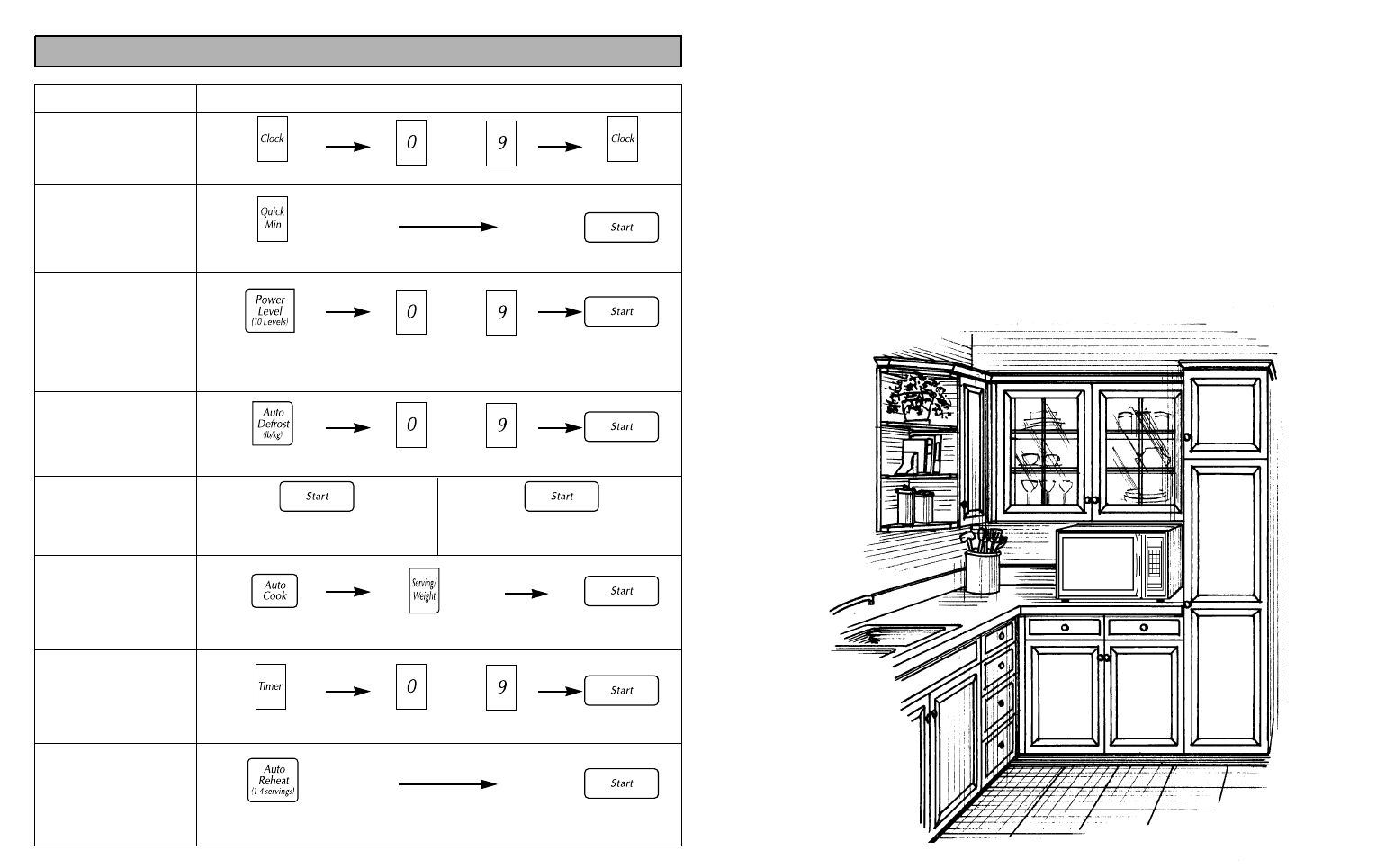
Operating Ins tructions
Microwave Oven
Models MS -164ZF
This manual contains S afety Instructions, Operating Instructions and Maintenance of the oven.
Before operating this oven, please read these instructions completely.
Antes de operar este producto, lea este instructivo en su totalidad.
E l manual de instrucciones en espa–ol puede ser encontrada en la p‡ginas 23-29
(S panish Operating Instructions can be found on pages 23-29)
Feature How to Operate
To S et C loc k
To C ook using
Quick Min P ad
To S et
P ower & Time
To Defrost using
Auto Defros t P ad
To Use as
a K itchen Timer
To reheat using
Auto R eheat P ad
(page 11)
E nter time of day.
P res s. P res s.
(up to 10 min.)
P res s. P res s.
To C ook using
Auto C ook P ads
QUIC K G UIDE TO OP E R ATION
P art No. 3828W5A2260
S elect recipe S elect serving/weight
eg.
To us e
C hild S afety Lock Hold ÒS tartÓ P ad until ÒLÓ
appears in the display.
Hold ÒS tartÓ P ad until ÒLÓ
disappears in the display.
Thru
S et weight.
P res s. P res s.
Thru
S et cooking time.
P ress to select
P ower Level
P res s.
Thru
Thru
P res s.
P res s.
P res s. P res s.
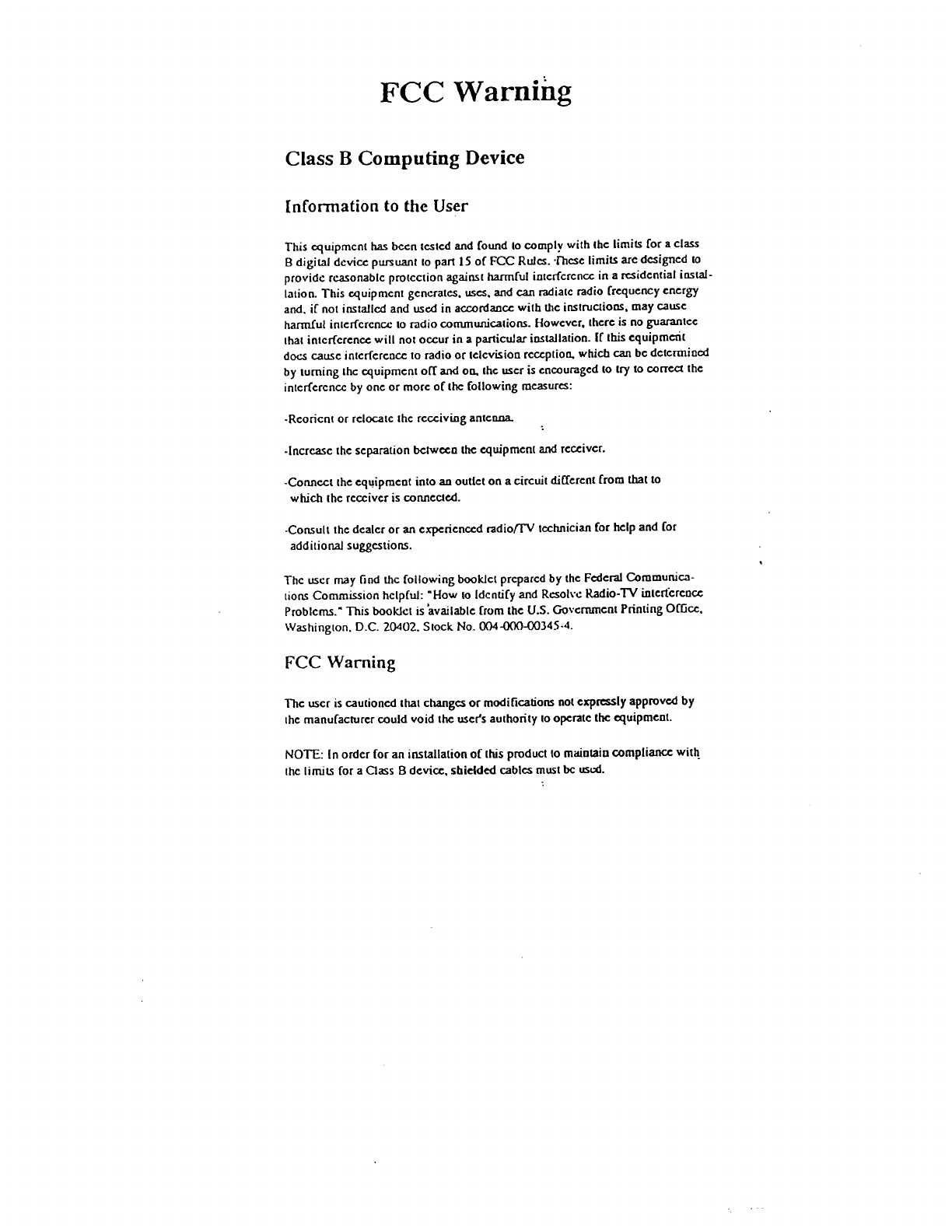
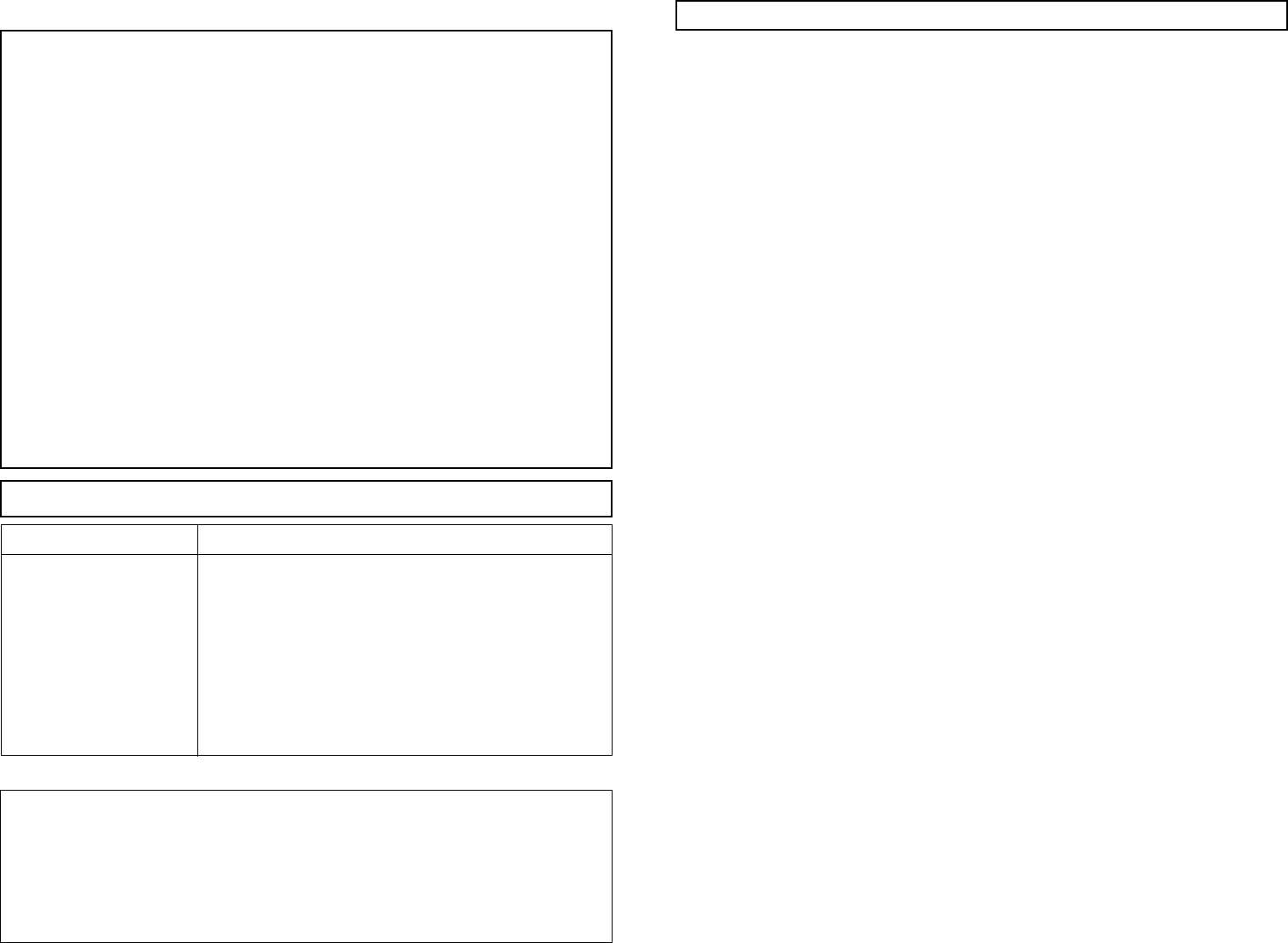
Thank you for purchasing the Panasonic Microwave Oven.
PRECAUTIONS TO AVOID
POSSIBLE EXPOSURE TO
EXCESSIVE MICROWAVE ENERGY
(a) Do not attempt to operate this oven with the door open since open-door
operation can result in harmful exposure to microwave energy. It is important
not to defeat or tamper with the safety interlocks. Under normal conditions
oven will not operate with door open.
(b) Do not place any object between the oven front face and the door or allow
soil or cleaner residue to accumulate on sealing surfaces.
(c) Do not operate the oven if it is damaged. It is particularly important that the
oven door close properly and that there is no damage to the:
(1) door (bent),
(2) hinges and latches (broken or loosened),
(3) door seals and sealing surfaces.
(d) The oven should not be adjusted or repaired by anyone except properly
qualified service personnel.
© Copyrighted by Matsushita Electric Industrial Co., Ltd. 2002.
The serial number of this product may be
found on the back side of the oven. You
should note the model number and the
serial number of this oven in the space
provided and retain this book as a perma-
nent record of your purchase for future ref-
erence.
Model No. _________________________
Serial No. _________________________
Date of Purchase ___________________
Technical Specifications
*IEC 60705 RATING STANDARD Specifications subject to change without notice.
2
Power Source:
Power Consumption:
Output:*
Outside Dimensions
(H x W x D):
Oven Cavity Dimensions
(H x W x D):
Operating Frequency:
Uncrated Weight:
120 V, 60 Hz
13.5 Amps, 1,600 W
1,200 W
1317/32” x 2219/32” x 17 5/16”
(344 x 573.5 x 440 mm)
10 9/32” x 16 9/16” x 16 11/16”
(261 x 421 x 424 mm)
2,450 MHz
Approx. 37.2 lbs. (16.9 kg)
MS-164ZF
Contents
Before Operating
Precautions...............................................................................................Inside Front Cover
Important Safety Instructions .............................................................................................4
Installation and Grounding Instructions............................................................................5
Safety Precautions .................................................................................................................6
Cookware and Utensil Guide .................................................................................................7
Feature Diagram ....................................................................................................................8
Control Panel .........................................................................................................................8
Operation
Clock Setting ..........................................................................................................................9
Child Safety Lock ...................................................................................................................9
Quick Min Function ................................................................................................................9
Power & Time Setting ........................................................................................................... 9
Timer Setting ........................................................................................................................10
Popcorn Function .................................................................................................................11
Auto Reheat .........................................................................................................................11
Auto Defrost .........................................................................................................................12
Auto Defrost Chart ...............................................................................................................13
Auto Cook ............................................................................................................................14
Auto Cook Chart ..................................................................................................................14
Food Characteristics ............................................................................................................15
Cooking Techniques........................................................................................................15-16
Using Your Microwave Oven...........................................................................................17-18
Heating or Reheating Guide ................................................................................................19
Fresh Vegetable Chart .........................................................................................................20
Quick Guide to Operation...................................................................................Back Cover
Maintenance
Technical Specifications .............................................................................Inside Front Cover
Care of Your Microwave Oven .............................................................................................21
Before Requesting Service ..................................................................................................22
Limited Warranty & Customer Services........................................................................23 - 24
Manual de instrucciones (Spanish Operating Instructions)
Instrucciones de Seguridad ......................................................................................25 - 26
Instrucciones para Conexión a Tierra..............................................................................26
Instrucciones de Instalación.............................................................................................27
Sugerencias Utiles ...............................................................................................................28
Panel de Control ..................................................................................................................29
El poder & el tiempo poniendo.............................................................................................29
Niveles de intensidad de las microondas ........................................................................... 30
Trace para el cocinero automatico.......................................................................................30
Guia Rapida de Operación ..................................................................................................31
3
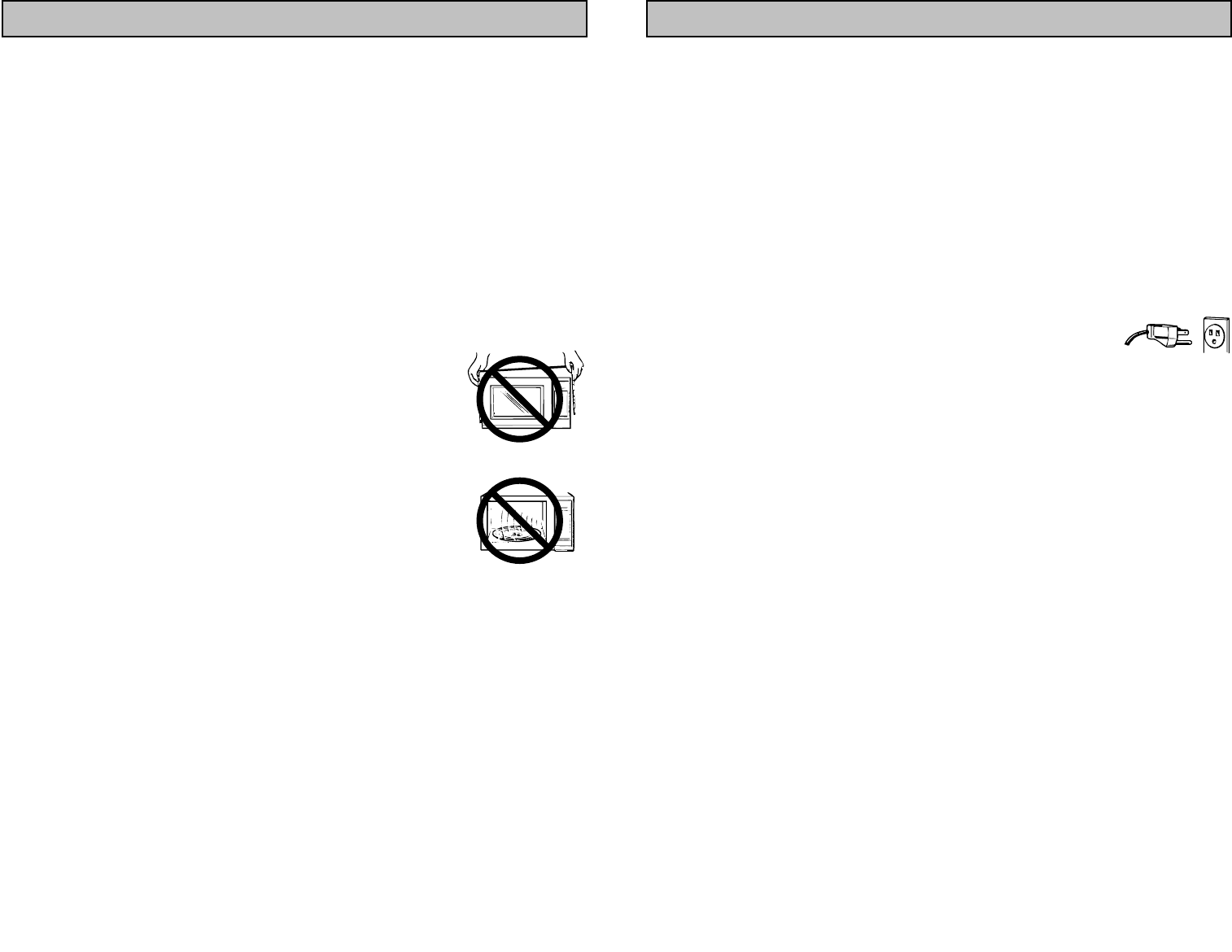
4
WARNING—To reduce the risk of burns, elec-
tric shock, fire, injury to persons, or exposure
to excessive microwave energy:
1. Read all instructions before using the
appliance.
2. Read and follow the specific “PRECAU-
TIONS TO AVOID POSSIBLE EXPO-
SURE TO EXCESSIVE MICROWAVE
ENERGY,” found on the inside front cover.
3. This appliance must be grounded. Connect
only to properly grounded outlet. See
“GROUNDING INSTRUCTIONS” found
on page 5.
4. Install or locate this appliance only in
accordance with the installation instruc-
tions found on page 5.
5. Do not cover or block any openings on this
appliance.
6. Do not store or use this appliance out-
doors.
Do not use this product near water—for
example, near a kitchen sink, in a wet
basement, or near a swimming pool, and
the like.
7. Use this appliance only for its intended use as
described in this manual. DO NOT use corro-
sive chemicals, vapors, or non-food products
in this appliance. This type of oven is specifi-
cally designed to heat or cook. It is not
designed for industrial or laboratory use. The
use of corrosive chemicals in heating or clean-
ing will damage the appliance and may result
in radiation leaks.
8. When cleaning surfaces of door and oven
that come together on closing the door,
use only mild, non-abrasive soaps or
detergents applied with a sponge or soft
cloth.
9. Do not allow children to use this appliance,
unless closely supervised by an adult.
10. Do not operate this appliance if it has a
damaged cord or plug, if it is not working
properly, or if it has been damaged or
dropped.
11. Do not immerse cord or plug in water.
12. Keep cord away from heated surfaces.
13. Do not let cord hang over edge of a table or
counter.
14. This appliance should be serviced only by
qualified service personnel. Contact the
nearest authorized servicenter for examina-
tion, repair or adjustment.
15. Some products such as whole eggs, nar-
row neck bottles and sealed containers—
for example, closed glass jars—may
explode and should not be heated in this oven.
16. To reduce the risk of fire in the oven cavity:
(a) Do not overcook food. Carefully attend
appliance if paper, plastic, or other com-
bustible materials are placed inside the
oven to facilitate cooking.
(b) Remove wire twist-ties from paper or
plastic bags before placing bag in oven.
(c) If materials inside the oven should
ignite, keep oven door closed, turn
oven off, and disconnect the power
cord, or shut off power at the fuse or
circuit breaker panel.
(d) Do not use the cavity for storage purpos-
es. Do not leave paper products, cooking
utensils, or food in the cavity when not in
use.
General Use
1. DO NOT tamper with or
make any adjustments or
repairs to door, Control
Panel housing, safety
interlock switches or any
other part of the oven. DO
NOT remove outer panel
from oven. Repairs
should only be done by a qualified service per-
son.
2. DO NOT operate the oven
empty. The microwave
energy will reflect continu-
ously throughout the oven
causing overheating, if
food or water is not pre-
sent to absorb energy. This could damage the
oven and result in the risk of a fire.
3. DO NOT dry clothes, newspapers or other mate-
rials in oven, or use newspapers or paper bags
for cooking. Fire could result.
4. DO NOT use recycled paper products unless the
paper product is labeled as safe for microwave
oven use. Recycled paper products may contain
impurities which may cause sparks, and result in
fires when used.
5. DO NOT hit or strike Control Panel. Damage to
controls may occur. Fire could result.
6. POT HOLDERS should always be used when
removing items from the oven. Heat is trans-
ferred from the HOT food to the cooking contain-
er and from the cooking container to the Glass
Tray. The Glass Tray can be very HOT after
removing the cooking container from the oven.
7. DO NOT store flammable materials next to, on top
of, or in the oven. These could be fire hazards.
SAVE THESE INSTRUCTIONS
For proper use of your oven read remaining safety cautions and operating instructions.
Y
our microwave oven is a cooking device and you should use as much care as you use with a
stove or any other cooking device. When using this electric appliance, basic safety precau-
tions should be followed, including the following:
Examine Your Oven
Unpack oven, remove all packing material and
examine the oven for any damage such as dents,
broken door latches or cracks in the door. Notify
dealer immediately if oven is damaged. DO NOT
install if oven is damaged.
Placement of Oven
1. Oven must be placed on a flat, stable surface.
For proper operation, the oven must have suffi-
cient air flow. Allow 4-inches (10 cm) of space
on both sides and top of oven.
a. DO NOT block air vents.
If they are blocked during operation, the
oven may be overheated and damaged.
When using any cloth over the oven, the air
intake and exhaust should not be blocked.
Also should allow space on back and both
sides of oven properly.
b. DO NOT place oven near a hot, damp sur-
face such as a gas or electric range, or
dishwasher.
c. DO NOT operate oven when room humidity
is too high.
2. This oven was manufactured for household
use only.
Grounding Instructions
This appliance must be grounded. In the event
of an electrical short circuit, grounding reduces
the risk of electric shock by providing an escape
wire for the electric current. This appliance is
equipped with a cord having a grounding wire with
a grounding plug. The plug must be plugged into
an outlet that is properly installed and grounded.
WARNING—Improper use of the grounding
plug can result in a risk of electric shock.
Consult a qualified electrician or service person if
the grounding instructions are not completely
understood, or if doubt exists as to whether the
appliance is properly grounded. If it is necessary
to use an extension cord, use only a three wire
extension cord that has a three blade grounding
plug, and a three slot receptacle that will accept
the plug on the appliance. The marked rating of
the extension cord should be equal to or greater
than the electrical rating of the appliance.
Power Supply
1. A short power-supply cord is provided to
reduce the risks resulting from becoming entan-
gled in or tripping over a longer cord.
2. Longer cord sets or extension cords are avail-
able and may be used if care is exercised in
their use.
3. If a long cord or extension cord is used, (1) the
marked electrical rating of the cord set or
extension cord should be at least as great as
the electrical rating of the appliance, (2) the
extension cord must be a grounding-type 3-wire
cord, and (3) the longer cord should be
arranged so that it will not drape over the
counter top or tabletop where it can be pulled
on by children or tripped over accidentally.
Wiring Requirements
1. The oven must be on a SEPARATE CIRCUIT.
No other appliance should share the circuit with
the microwave oven. If it does, the branch cir-
cuit fuse may blow, the circuit breaker may trip,
or the food may cook slower than the times
recommended in this manual.
2. The VOLTAGE used must be the same as
specified on this microwave oven (120 V, 60
Hz). Using a higher voltage is dangerous and
may result in a fire or other incident causing
oven damage. Using a lower voltage will cause
slow cooking. Panasonic is NOT responsible
for damage resulting from the use of the oven
with other than the specified voltage.
3. The oven must be plugged into at least a 20
AMP, 120 VOLT, 60 Hz GROUNDED OUTLET.
Where a standard two-prong outlet is encoun-
tered, it is the personal responsibility and oblig-
ation of the consumer to have
it replaced with a properly
grounded three-prong out-
let.
TV / Radio Interference
1. Operation of the microwave oven may cause
interference to your radio, TV or similar equip-
ment.
2. When there is interference, it may be reduced
or eliminated by taking the following measures:
a. Clean door and sealing surfaces of the oven.
(See Care of Your Microwave Oven)
b. Place the radio, TV, etc. away from the
microwave oven as far as possible.
c. Use a properly installed antenna to obtain
stronger signal reception.
Glass Tray
1. DO NOT operate the oven without Rotating
Ring and Glass Tray in place.
2. DO NOT operate the oven without the Glass
Tray fully engaged on the drive hub. Improper
cooking or damage to the oven could result.
Verify that the Glass Tray is properly engaged
and rotating by observing its rotation when you
press Start.
3. Only use the Glass Tray specifically designed
for this oven. Do not substitute any other glass
tray.
4. If the Glass Tray is hot, allow to cool before
cleaning or placing in water.
5. DO NOT cook directly on the Glass Tray.
Always place food in a microwave-safe dish, or
on a rack set in a microwave-safe dish.
6. If food or utensil on Glass Tray touches oven
walls, causing the tray to stop moving, the tray
will automatically rotate in the opposite direc-
tion. This is normal.
7. Glass Tray can turn in either direction.
Rotating Ring
1. Rotating Ring and oven floor should be cleaned
frequently to prevent excessive noise.
2. Rotating Ring must always be used for cooking
along with Glass Tray.
3. Always replace Rotating Ring and Glass Tray
in their proper positions.
5
IMPORTANT SAFETY INSTRUCTIONS
Installation and Grounding Instructions
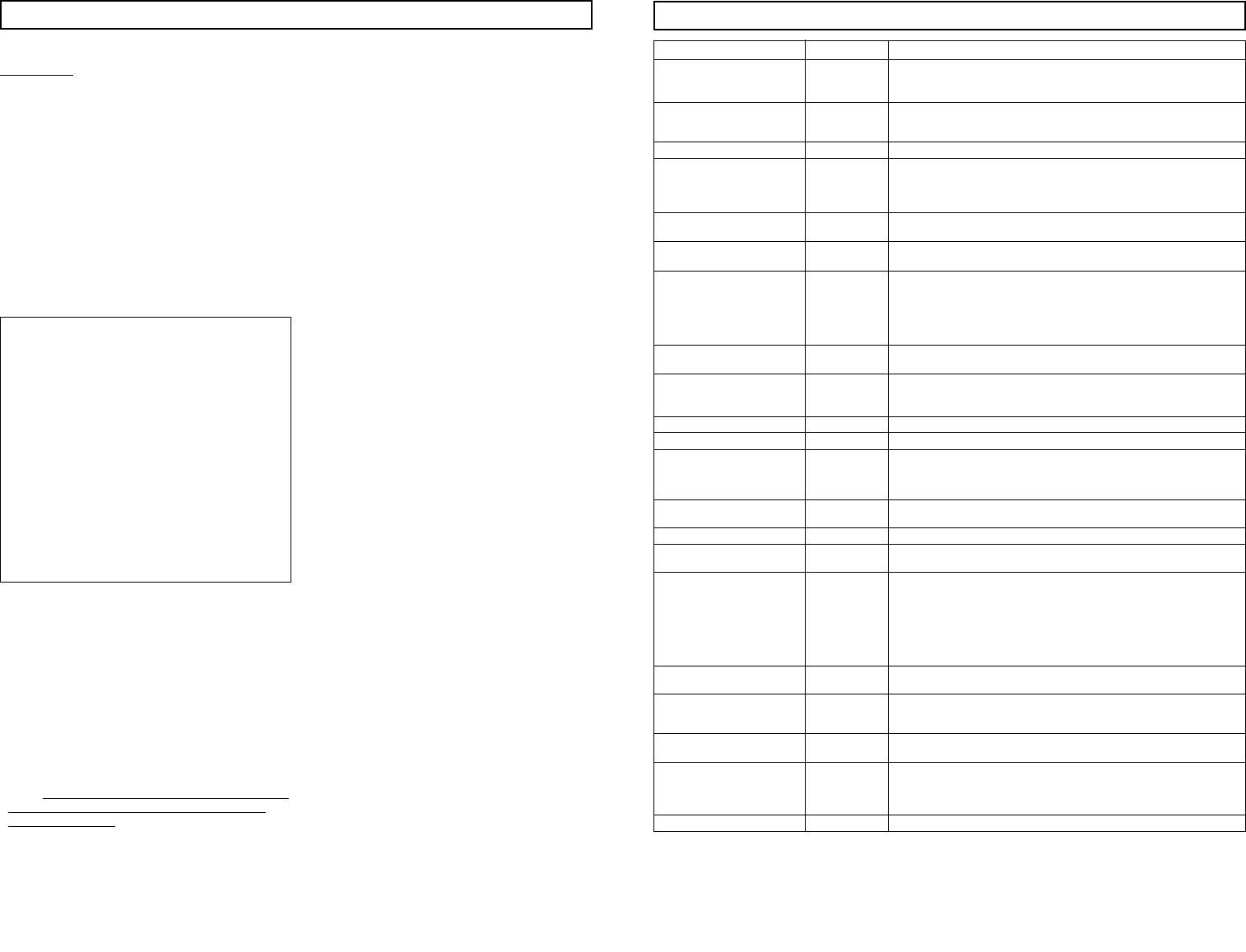
6
Safety Precautions
IMPORTANT
Proper cooking depends upon the power, the
time set and the quantity of food. If you use a
smaller portion than recommended and cook at
the time for the recommended portion, fire can
result.
1) HOME CANNING / DRYING FOODS / SMALL
QUANTITIES OF FOODS
•DO NOT use your oven for home canning, your
oven cannot maintain the food at the proper can-
ning temperature. Improperly canned food may
spoil and be dangerous to consume.
• DO NOT dry meats, herbs, fruits or vegetables in
your oven. Small quantities of food or foods with
low moisture content can dry out, scorch or catch
on fire if overheated.
2) POPCORN
3) DEEP FAT FRYING
•DO NOT attempt to deep fat fry in your
microwave oven. Cooking oils may burst into
flames and may cause damage to the oven and
perhaps result in burns. Microwave utensils may
not be able to withstand the temperature of the
hot oil, and could shatter or melt.
4) FOODS WITH NONPOROUS SKINS
•Potatoes, apples, whole eggs, egg yolks,
whole squash and sausages are examples of
foods with nonporous skins. These types of
foods must be pierced before microwave cooking
to prevent their bursting.
•Use fresh potatoes for baking and cook until just
done. Use recommended weights for programmed
cooking. Overcooking causes dehydration and
may result in a fire.
5) LIQUIDS
•
Liquids can become "superheated" in a
microwave, and when the container is moved in
any way, the superheated liquids can
"explode" out of the container.
"Superheated" water is hotter than boiling
water, EVEN THOUGH IT DOES NOT
APPEAR TO BUBBLE. To reduce the possibility
of this occurrence:
Always make sure that liquids are stirred
vigorously before heating to assure that the
liquid is mixed with air. NEVER HEAT LIQUIDS
FOR AN EXCESSIVE LENGTH OF TIME.
6) GLASS TRAY / COOKING UTENSILS / FOIL
•Cooking utensils get hot during microwaving. Heat
is transferred from the HOT food to the container
and the Glass Tray. Use potholders when remov-
ing utensils from the oven or when removing lids
or plastic wrap covers from cooking utensils to
avoid burns.
•The Glass Tray will get hot during cooking. It
should be allowed to cool before handling or
before paper products, such as paper plates or
microwave popcorn bags, are placed in the oven
for microwave cooking.
•When using foil, skewers, warming rack or uten-
sils made of metal in the oven, allow at least 1-
inch (2.5 cm) of space between metal material
and interior oven walls. If arcing occurs (spark-
ing), remove metal material (skewers etc.) and/or
transfer to a non-metallic container.
•Dishes with metallic trim should not be used, as
arcing may occur.
•If an entree is heated in a foil tray, maintain at
least 1-inch (2.5 cm) spacing from the oven walls.
7) PAPER TOWELS / CLOTHS
•DO NOT use paper towels or cloths which con-
tain a synthetic fiber woven into them. The syn-
thetic fiber may cause the towel to ignite. Use
paper toweling under supervision.
8) BROWNING DISHES / OVEN COOKING BAGS
•Browning dishes or grills are designed for
microwave cooking only. Always follow instruc-
tions provided by the manufacturer. DO NOT
preheat browning dish more than 6 minutes.
•If an oven cooking bag is used for microwave
cooking, prepare according to package directions.
DO NOT use a wire twist-tie to close bag,
instead use plastic ties, cotton string or a strip cut
from the open end of the bag.
9) THERMOMETERS
•DO NOT use a conventional meat thermometer
in your oven. Arcing may occur. Microwave-safe
thermometers are available for both meat and
candy.
10) BABY FORMULA / FOOD
• DO NOT heat baby formula or food in the
microwave oven. The glass jar or surface of the
food may appear to be only warm while the interi-
or can be so hot as to burn the infant’s mouth and
esophagus.
11) REHEATING PASTRY PRODUCTS
• When reheating pastry products, check tempera-
tures of any fillings before eating. Some foods
have fillings which heat faster and can be
extremely hot, while the surface remains warm to
the touch (ex. Jelly Donuts).
12) GENERAL OVEN USAGE GUIDELINES
•DO NOT use the oven for any reason other than
the preparation of food.
•DO NOT leave oven unattended while in use.
Follow These Safety Precautions When Cooking in Your Oven
Popcorn may be popped in a microwave oven
corn popper. Microwave popcorn which pops in
its own package is also available. Follow pop-
corn manufacturers’ directions and use a brand
suitable for the wattage of your microwave oven.
CAUTION: When using pre-packaged
microwave popcorn, follow recommended
package instructions. Check package weight
before using the Popcorn pad (see Popcorn
Pad section). Set the oven for the weight of
the popcorn package.
If these instructions are not followed, the
popcorn may not pop adequately or may
ignite and cause a fire. Never leave oven
unattended when popping popcorn. Allow
the popcorn bag to cool before opening,
always open the bag away from your face
and body to prevent steam burns.
7
Cookware and Utensil Guide
ITEM MICROWAVE COMMENTS
Yes for Small strips of foil can be molded around thin parts of
Aluminum Foil Shielding meat or poultry to prevent overcooking. Arcing can occur
only if foil is too close to oven wall or if too much foil is used.
Browning Dish Yes Browning dishes are designed for microwave cooking
only. Check browning dish information for instructions
and heating chart. Do not preheat for more than 6 minutes.
Brown paper bags No May cause a fire in the oven.
Dinnerware Check manufacturers' use and care directions for use in
Labeled Yes microwave heating. Some dinnerware may state on the
“Microwave-Safe” back of the dish, “Oven-Microwave Safe”.
Other Dinnerware ? Use CONTAINER TEST below.
Disposable polyester Yes Some frozen foods are packaged in these dishes. Can be
Paperboard Dishes purchased in grocery stores.
Fast Food Carton No Metal handle may cause arcing.
with Metal Handle
Frozen Dinner Tray Frozen dinners may be heated in foil tray, if tray is less than
Metal Yes 3/4-in.(2 cm) high. Place foil tray in center of oven. Leave at
least 1-in. (2.5 cm) space between foil tray and oven walls.
Microwave-safe Yes Heat only 1 foil tray in the oven at a time. For containers
more than 3/4-inch (2 cm) deep,remove food and place in a
similar size microwave-safe container.
Glass Jars Yes, Remove lid. Heat food until just warm, not HOT. Most glass
use caution jars are not heat resistant. Do not use for cooking.
Glassware
Heat Resistant Oven Yes Ideal for microwave cooking and browning.
Glassware & Ceramics (See CONTAINER TEST below)
Metal Bakeware No Not recommended for use in microwave ovens.
Metal Twist-Ties No May cause arcing which could cause a fire in the oven.
Follow manufacturers' directions. Close bag with the nylon tie
Oven Cooking Bag Yes provided, a strip cut from the end of the bag, or a piece of
cotton string. Do not close with a metal twist-tie. Make six
1/2-in. (1 cm) slits near the closure.
Paper Plates & Cups Yes Use to warm cooked foods, and to cook foods that require
short cooking times such as hot dogs.
Paper Towels & Napkins Yes Use to warm rolls and sandwiches by microwave.
Parchment Paper Yes Use as a cover to prevent spattering. Safe for use in
microwave, microwave/convection and conventional ovens.
Plastic
Microwave-Safe Yes Should be labeled, "Suitable for Microwave Heating." Check
Cookware manufacuters’ directions for recommended uses.
Reheat & Storage Yes, Some microwave-safe plastic dishes are not suitable for
use caution cooking foods with high fat or sugar content. The heat from
hot food may cause the plastic to warp.
Melamine No This material absorbs microwave energy. Dishes get HOT!
Plastic Foam Cups Yes, Plastic foam will melt if foods reach a high temperature. Use
use caution to bring foods to a low serving temperature.
Use to cover food during cooking to retain moisture and
Plastic Wrap Yes prevent spattering. Should be labeled “Suitable for
Microwave Heating”. Check package directions.
Straw, Wicker, Wood Yes Use only for short term reheating and to bring
food to a low serving temperature.
Thermometers
Microwave-safe, only Yes Use only microwave-safe meat and candy thermometers.
Conventional No Not suitable for use in microwave oven, will cause sparks
and get hot.
Wax paper Yes Use as a cover to prevent spattering and to retain moisture.
CONTAINER TEST
TO TEST A CONTAINER FOR SAFE MICROWAVE OVEN USE: Fill a 1- cup glass measure with water
and place it in the microwave oven along with the container to be tested; heat one (1) minute at P10
(HIGH). If the container is microwave oven-safe (transparent to microwave energy), the container should
remain comfortably cool and the water should be hot. If the container is hot, it has absorbed some
microwave energy and should NOT be used. This test cannot be used for plastic containers.
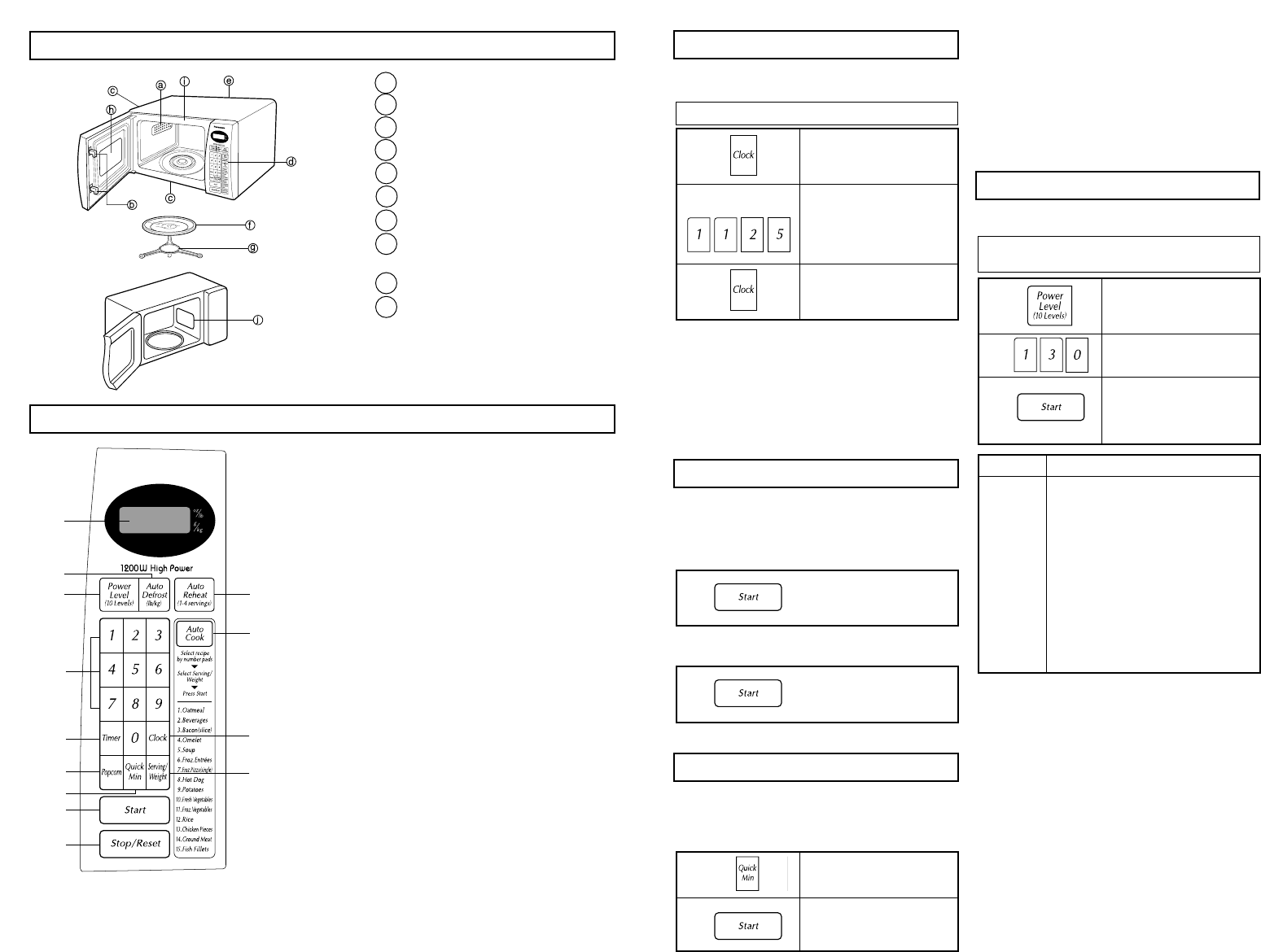
8
Feature Diagram
Control Panel
Internal Air Vents
Door Safety Lock System
External Air Vents
Control Panel
Identification Plate
Glass Tray
Rotating Ring
Heat/Vapor Barrier Film
(do not remove)
Menu Label
Cover (do not remove)
e
a
f
d
c
b
g
h
i
j
Beep Sound:
When a pad is pressed correctly, a beep will be heard.
If a pad is pressed and no beep is heard, the unit did not or cannot accept the
instruction. The oven will beep twice between programmed stages. At the end of any
complete program, the oven will beep.
ባ
ቤ
ቧ
ቨ
ቩቭ
ብ
ቦ
ቢ
ቪ
ቯ
ቫ
ቮ
1. DISPLAY WINDOW.
2. AUTO DEFROST PAD (Page 12)
3. POWER LEVEL PAD (Page 9)
4. AUTO REHEAT PAD (Page 11)
5. AUTO COOK PAD (Page 14)
6. NUMBER PAD
7. TIMER PAD (Page 10)
8. POPCORN PAD (Page 11)
9. QUCIK MIN PAD (Page 9)
10. CLOCK PAD (Page 9)
11. SERVING/WEIGHT PAD (Page 14)
12. START PAD.
One tap allows oven to begin functioning. If door is
opened or STOP/RESET pad must be pressed again
to restart oven.
13. STOP/RESET PAD.
Before cooking: One tap clears your instruction.
During cooking: One tap temporarily stops the
cooking process. Another tap cancels all your
instructions and time of day or colon appears on the
Display Window.
9
Clock Setting
Child Safety Lock
The oven will operate without setting the
clock.
NOTES:
1. To reset the clock, repeat steps 1-3.
2. The clock will keep the time of day as long
as the oven is plugged in and electricity is
supplied.
3. Clock is a 12 hour display.
4. Oven will not operate while colon is flashing.
NOTES:
1. You can use other power levels, select desired
power level before setting cooking time.
2. After setting the time by Quick Min Pad, you
cannot use Number Pads, and vice versa.
3. Press Quick Min Pad to add more time during
cooking. To verify the additional cooking time,
check the Display Window.
NOTES:
1. For more than one stage cooking, repeat
steps 1 and 2 for each stage of cooking
before pressing Start Pad.
2. When selecting P10 (HIGH) power for the
first stage, you may begin at step 2.
3. Two beeps will sound between each stage
of programming. Five beeps will sound at
the end of the enrire sequence.
4. When selecting P10 (HIGH) power, the
maximum programmable time is 30 minutes.
For other power levels, the maximum time is
99 minutes and 99 seconds.
5. For reheating, use P10 (HIGH) for liquids,
P7 (MEDIUM-HIGH) for most foods and P6
(MEDIUM) for dense foods.
6. For defrosting, use P3 (MEDIUM-LOW).
You can use this safety feature to lock the
control panel so that children cannot use the
oven when you do not want them.
1.
2.
3.
• Press once.
➤Colon flashes.
• Enter time of day using
the number pads.
➤Time appears on the
Display Window: Colon
continues flashing.
• Press.
➤Colon stops flashing;
time of day is entered.
1. • Hold until “L”.
appears from the
display.
Example: To set 11:25 a.m. or p.m.
To set CHLID SAFETY LOCK:
1. • Hold until “L”.
appears from the
display.
To cancel CHLID SAFETY LOCK:
Quick Min Function
This feature allows you to set and/or add cook-
ing times easily in multiples of one minute.
1.
2.
• Set cooking time
(up to 10 taps/minutes)
To set Standing Time:
Power & Time Setting
How do I program Power and Time?
1.
2.
3.
• Select Power Level.
(according to the
chart below)
• Set Cooking Time using
number pads.
Press
once
twice
3 times
4 times
5 times
6 times
7 times
8 times
9 times
10 times
Power Level
P10 (HIGH)
P9
P8
P 7 (MEDIUM-HIGH)
P 6 (MEDIUM)
P5
P4
P 3 (MEDIUM-LOW)/DEFROST
P2
P 1 (LOW)
• Press.
➤Cooking will start. The
time on the screen will
count down.
Example: To cook at P6 (MEDIUM) Power
for 1 minute 30 seconds.
• Press Start Pad.
➤Cooking will start on
P10(HIGH) power.
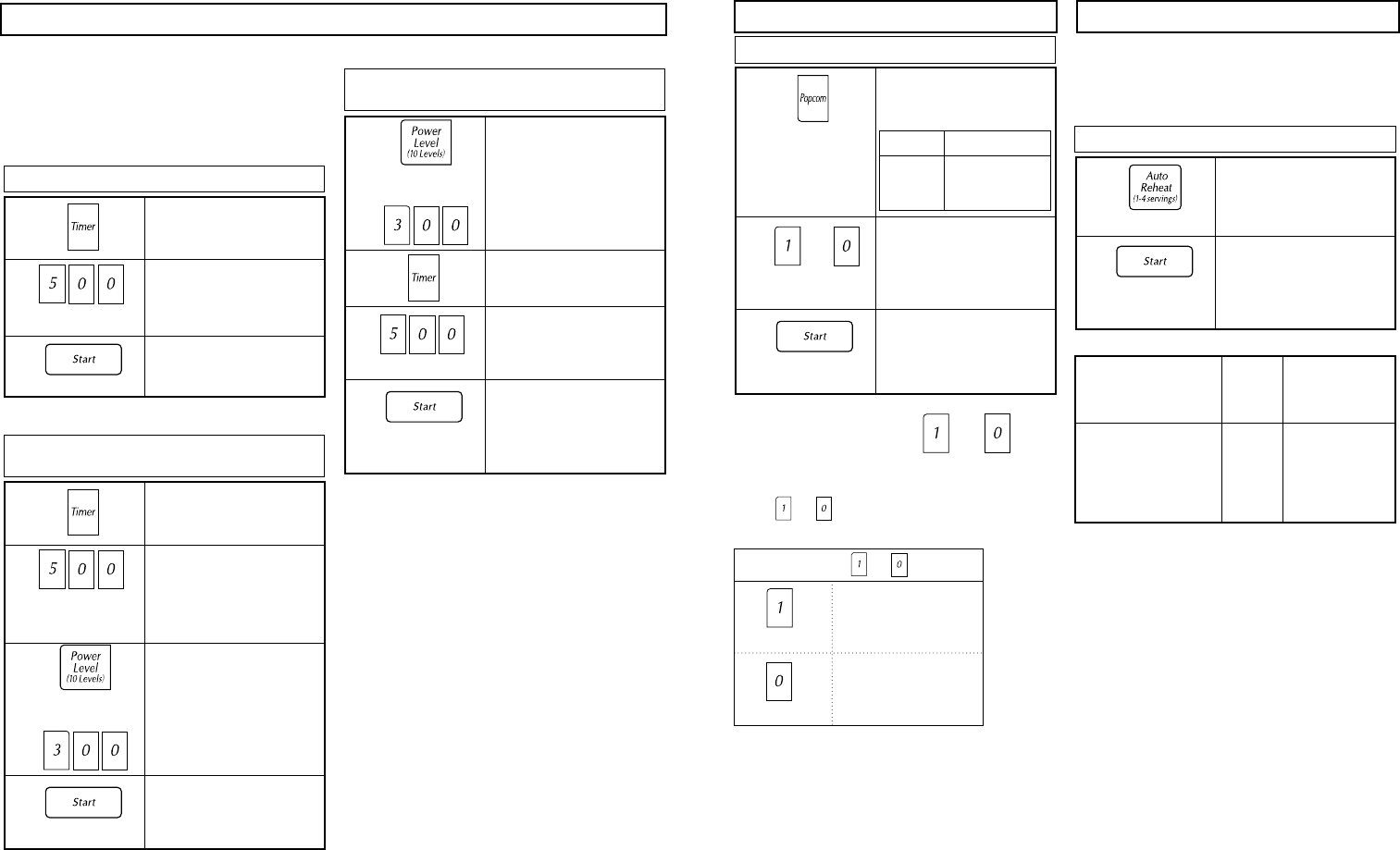
1110
Timer Setting Auto ReheatPopcorn Function
Ingenious Use by or
This feature allows you to program a
Standing Time after cooking is completed
and to program the oven as a minute timer
and/or to program a delay start.
NOTES:
1. If oven door is opened during Stand Time or
Kitchen Timer, the time on the screen will
continue to count down.
2. Stand Time and Delay time cannot be pro-
grammed before any Auto Control Function.
This is to prevent the starting temperature of
food from rising before defrosting or cooking
begins. A change in starting temperature
could cause inaccurate results.
NOTES: For best results, follow these recom-
mendations:
1. All foods must be previously cooked.
2. Foods should always be covered loosely with
plastic wrap, wax paper or casserole lid.
3. All foods should have a covered stand time of
3 to 5 minutes.
4. DO NOT reheat bread and pastry products
using Auto Reheat Use manual power and
time instead.
5. DO NOT reheat beverages.
6. Times are based on an approximate serving
size of 4 oz.
7. A plate of food is normally 3-4 servings.
REMARK: When popping multiple bags one
right after the other, the cooking times may
vary slightly. This does not affect the popcorn
results.
CAUTION: If pre-packaged popcorn is a dif-
ferent weight than is recommended. Do not
use the popcorn setting, or inadequate pop-
ping or a fire may occur. Follow the manufac-
turers instructions.
1.
2.
3.
• Press.
• Set desired amount of
time using number pads.
(up to 99 minutes and
99 seconds.)
• Press.
➤Time will count down
without oven operating.
To Use as a Kitchen Timer:
Example: To count 5 minutes
This feature allows you to reheat 1 to 4 serv-
ings of precooked room temperature and
refrigerator temperature foods without setting
power and time.
When using popcorn pad, maybe the weight is
not the same as offered. By using the number
pads or , the programs can be adjusted
to cook for a heavier or lighter weight.
1 tap= More+
2 taps= More++
Press
1 tap= Less+
2 taps= Less++
1.
2.
• Press until the
desired number of
servings appears in
the Display Window.
Example: To reheat 2 cups of soup
1.
3.
2.
• Set the desired weight
of prepackaged
microwave popcorn.
• Press Start Pad.
➤Cooking time appears in
the display and begins to
count down.
• Press.
➤Cooking time appears in
the Display Window
and begins to count
down.
Example: To heat 1.75 oz. of Popcorn
1.
2.
3.
4.
• Press once.
5 times
• Enter desired amount of
delayed time using
number pads.
(up to 99 minutes and
99 seconds.)
• Enter the desired cooking
program (see page 7 for
directions)
➤
To Set Delay Start:
Example: To start cooking 5 minutes later.
(3 mins. at MEDIUM Power.)
• Press.
➤Delayed time will count
down. Then cooking will
start.
1.
2.
3.
4.
• Press once.
5 times
Press twice
• Enter the desired cooking
program (see page 7 for
directions)
➤
Press
To Set Stand Time:
Example: To stand for 5 mins. after cooking
(3 mins. at MEDIUM Power)
• Press.
➤Cooking will start.
After cooking, stand time
will count down without
oven operating.
• Set desired amount of
Stand Time using num-
ber pads. (up to 99 min-
utes and 99 seconds.)
Press
once
twice
3 times
1.75 oz. (50g)
3.0 oz. (85g)
3.5 oz. (99g)
Weight
Press Auto Reheat
pad to indicate
number or servings
once
twice
three times
four times
Average
Serving
Size
4-6 oz.
8 oz.
12 oz.
16 oz.
Time
will vary
depending
on size and
wattage of oven
or
Optional
To control by or pad:
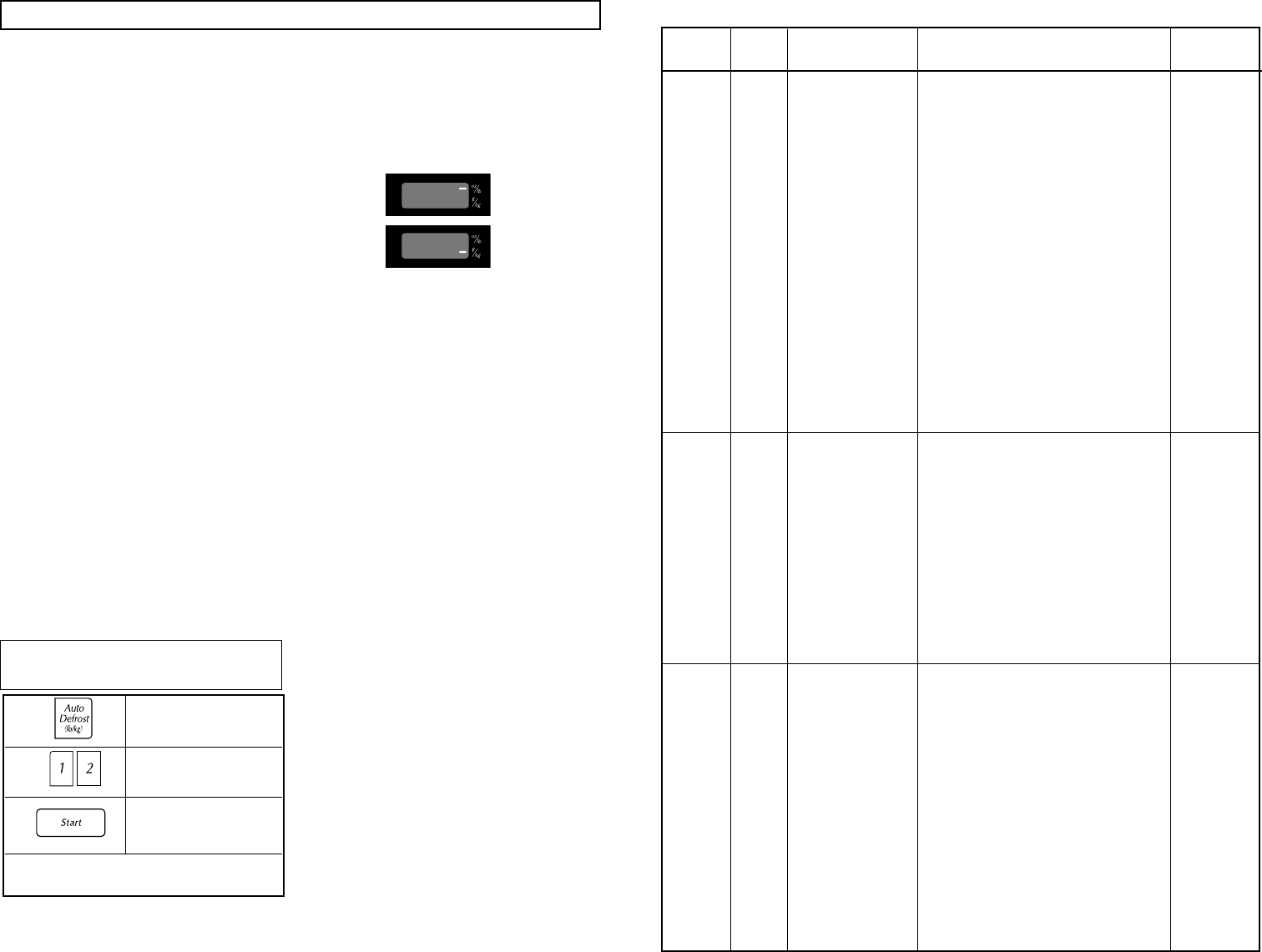
1312
POULTRY
(dEF2)
twice
3 times
Poultry
Whole Chicken
Chicken Pieces
Cornish Hens: Whole,
Split
Turkey
Breast (under 6 lbs.)
Turn over. Finish defrosting breast-side
down. Cover warm areas with aluminum
foil.
Separate pieces and rearrange.
Turn over. Cover warm areas with
aluminum foil.
Turn over and arrange.
10-20 min.
Rinse under cold
running water.
5-10 min.
10-20 min.
Rinse under cold
running water.
10-20 min.
Rinse under cold
running water.
STEAKS/
CHOPS
(dEF3)
Beef Steaks
Pork Chops
Lamp Chops
Fish
Steaks, whole fish
fillets
Shellfish
Crabmeat, Shrimp
Lobster tails
Scallops
Turn over. Cover warm areas with
aluminum foil.
Same as above.
Same as above.
Turn over and rearrange. Cover head
and tail with foil.
Turn over. Separate fillets when partially
thawed if possible.
Rearrange and break apart.
Turn over and rearrange.
Turn over and rearrange.
10-20 min.
10-20 min.
10-20 min.
5 min.
5 min.
Rinse with cold
water to separate.
5 min.
5 min.
5 min.
At Reminder Tone
Turn over. Remove thawed portions and
break apart. Return remainder to oven.
Turn over. Remove thawed portions with
fork.
Turn over.
Turn over. Cover warm areas with
aluminum foil.
Same as above.
Turn over.
Turn over.
Turn over.
Turn over. Cover warm areas with
aluminum foil.
Turn over. Cover warm areas with
aluminum foil.
Same as above.
Standing
Time
5 min.
5 min.
5 min.
10-20 min.
10-20 min.
10-20 min.
2 min.
5 min.
5 min.
10-20 min.
10-20 min.
10-20 min.
AUTO DEFROST CHART
Category
GROUND
MEAT
(dEF1)
Touch
keypad
once
Food
to be Defrosted
Beef
Ground beef
Cubes for stew
Hamburger patties
Pot roast
Rib roast, Rump roast,
Chuck roast
Pork
Bacon, Hot dogs
Sausage links
Sausage patties
Ribs, Roast
Lamb
Ribs
Roasts
Auto Defrost
AUTO DEFROST thaws frozen food with-
out entering a cook time or cook power.
Three defrost categories are preset in your
oven: Ground Meat, Poultry, and
Steaks/Chops. See the Auto Defrost Chart
on the next page.
NOTES:
• For added convenience, AUTO
DEFROST has a built-in reminder tone to
tell you when to check, turn over, sepa-
rate, or rearrange food. The oven will
sound a tone during the defrost cycle. At
the tone, open the door and turn, separate,
or rearrange food. Remove any portion that
have thawed. Return frozen portion to the
oven and touch START to resume the
defrost cycle.
• You can defrost foods that weight 0.1 to
6.0 lbs (0.1 to 4.0 kg).
For best results:
• Remove fish, shellfish, meat, and poultry
from its original closed paper or plastic
package (wrapper). Otherwise, the wrap
will hold steam and juice close to the
foods, which can cause the outer surface
of the foods to cook.
• Shape ground meat into the form of a
doughnut before freezing. When defrost-
ing, remove thawed meat when the
reminder tone sounds and continue
defrosting.
• Place foods in a shallow container or on a
microwave roasting rack to catch drip-
pings.
• Food should still be somewhat icy in the
center when removed from the oven.
To choose the unit of weight (oz/lb or g/kg).
1. You can choose the unit of weight when
you turn on a oven.
2.
If you don’t select a unit when you just turn
on a oven, the oven will be selected to
“oz/lb”.
oz/lb
g/kg
Touch the “start” pad
At the end of the defrost time, five short tones
will sound. The oven will stop.
Example: To defrost 1.2 lbs. of ground
beef.
1.
2.
3.
4.
• to enter 1.2 lbs.
•
once for Meat.
• Press.
➤To start the oven.
(Time counting down.)
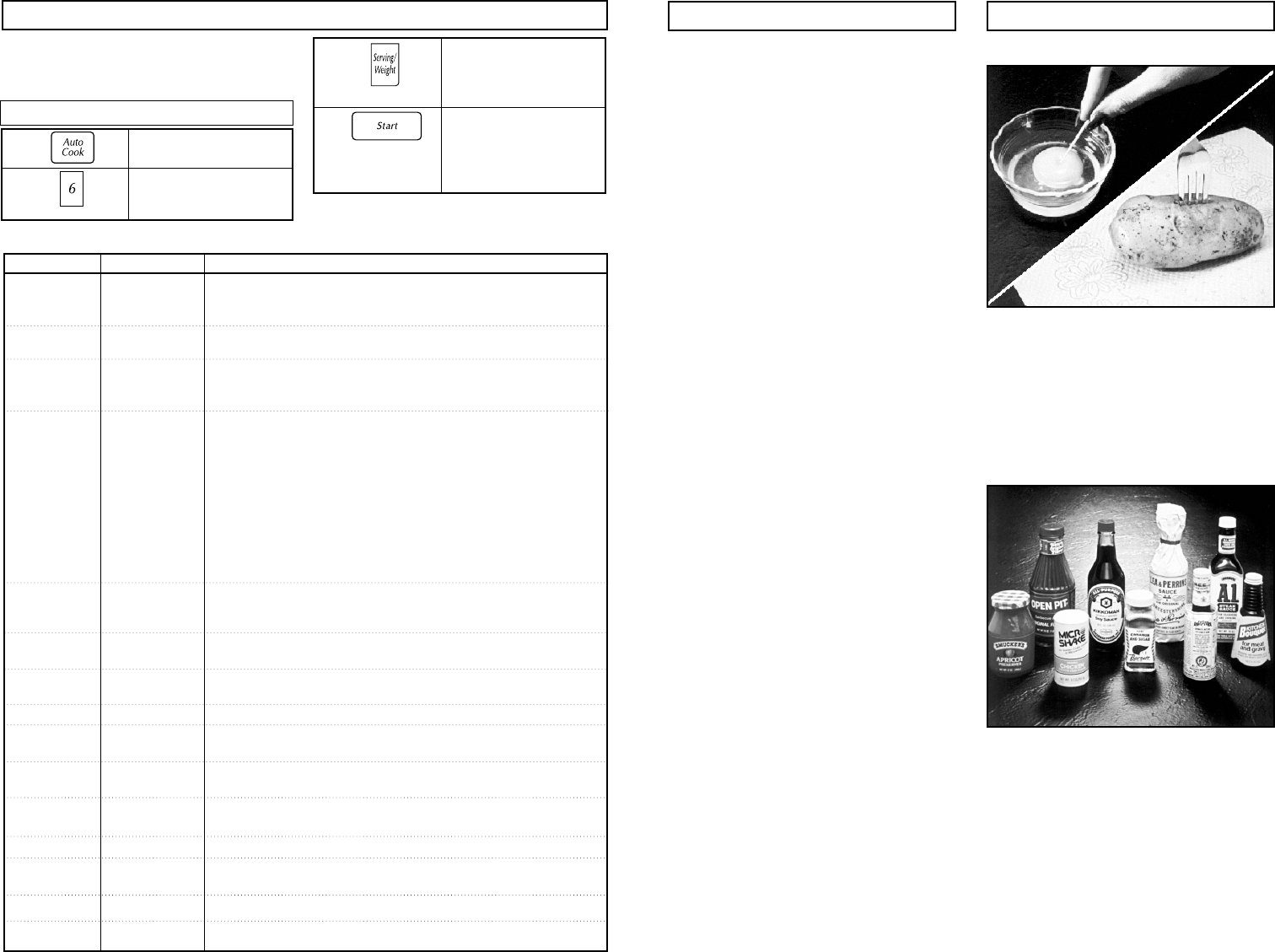
1514
Food Characteristics Cooking Techniques
Bone and Fat
Both bone and fat affect cooking. Bones may
cause irregular cooking. Meat next to the tips of
bones may overcook while meat positioned under
a large bone, such as a ham bone, may be
undercooked. Large amounts of fat absorb
microwave energy and the meat next to these
areas may overcook.
Density
Porous, airy foods such as breads, cakes or rolls
take less time to cook than heavy, dense foods
such as potatoes and roasts. When reheating
donuts or other foods with different centers be
very careful. Certain foods have centers made
with sugar, water or fat and these centers attract
microwaves (For ex., jelly donuts). When a jelly
donut is heated, the jelly can become extremely
hot while the exterior remains warm to the touch.
This could result in a burn if the food is not
allowed to cool properly in the center.
Quantity
Two potatoes take longer to cook than one pota-
to. As the quantity of the food increases so does
the cooking time. When cooking small amounts of
food such as one or two potatoes, do not leave
oven unattended. The moisture content in the
food may decrease and a fire could result.
Shape
Uniform sizes heat more evenly. The thin end of a
drumstick will cook more quickly than the meaty
end. To compensate for irregular shapes, place
thin parts toward the center of the dish and thick
pieces toward the edge.
Size
Thin pieces cook more quickly than thick pieces.
Starting Temperature
Foods that are room temperature take less time
to cook than if they are chilled or refrigerated or
frozen.
Piercing
Foods with skins or membranes must be pierced
scored or have a strip of skin peeled before cook-
ing to allow steam to escape. Pierce whole egg
yolks and whites, clams, oysters, chicken livers,
whole potatoes and whole vegetables. Whole
apples or new potatoes should have a 1-inch strip
of skin peeled before cooking. Score sausages
and frankfurters.
Browning
Foods will not have the same brown appearance
as conventionally cooked foods or those foods
which are cooked utilizing a browning feature.
Meats and poultry may be coated with browning
sauce, Worcestershire sauce, barbecue sauce or
shake-on browning sauce. To use, combine
browning sauce with melted butter or margarine;
brush on before cooking.
For quick breads or muffins, brown sugar can be
used in the recipe in place of granulated sugar, or
the surface can be sprinkled with dark spices
before baking.
Auto Cook
Use this function to cook food without enter-
ing a cook time or power. Refer to the Auto
Cook Chart below for more information.
AUTO COOK CHART
Pad
1. Oatmeal
2. Beverages
3. Bacon (slice)
4. Omelet
5. Soup
6. Frozen
Entrees
7. Frozen
Pizza (single)
8. Hot Dog
9. Potatoes
10. Fresh
Vegetables
11. Frozen
Vegetables
12. Rice
13. Chicken
Pieces
14. Ground Meat
15. Fish Fillets
Serving/Weight
1/2, 1 cup
1, 2 cups
4, 6, 10 slices
2, 4 eggs
1, 2 cups
10, 20 oz.
4, 8 oz.
1, 2, 3, 4 pieces
1, 2, 3, 4 pieces
4, 8, 12, 16 oz.
6, 10, 16 oz.
1/2, 1, 11/2cups
6, 12, 18, 24 oz.
16, 32 oz.
4, 8, 12, 16 oz.
Hints
Put amount of oatmeal in a microwave-safe cup and
add water according to the manufacturers’ directions.
No cover. Stir thoroughly after heating.
Use mug or microwave-safe cup with no cover.
Stir after reheating.
Place slices of bacon on a 3 sheet of paper towel on
microwave-safe dish. Cover with paper towel. Use ‘more / less’
function according to the brand, thickness or preference.
< Ingredients for 2 eggs >
1 tablespoon butter or margarine
2 tablespoons milk
salt and ground black pepper
Melt butter in a 9-inch pie plate, turn the plate to coat
the bottom with butter.
Combine the remaining ingredients and pour into
the pie plate and cover with plastic wrap.
Let stand 2 minutes.
With a spatura, loosen the edges of the omelet
from the plate; fold into thirds to serve.
Pour soup into a microwave-safe bowl.
Cover loosely with lid or vented plastic wrap.
Stir after reheating.
Follow manufacturers’ directions for covering.
Follow manufacturers’ directions.
Make slits on hot dogs and place on paper towels.
Pierce skin with a fork and place potatoes on paper
Towel. Do not cover. Stand 5 minutes after cooking.
All pieces should be the same size.
Add small amount of water and cover with lid or plastic wrap.
Add small amount of water and cover with lid or vented
plastic wrap. Stir thoroughly at beep for even cooking.
Add double amount of hot water and cover with plastic wrap.
Place chicken pieces with skin side up and cover with
plastic wrap.
Cover with plastic wrap. Stir thoroughly at beep for even cooking
Place fish fillets in a single layer and cover with plastic wrap.
1.
2.
• Press.
Example: To cook a 10 oz. Frozen Entrée
• Select the desired cate-
gory number using the
number pads.
3.
4.
• Press until the
desired quantity
appears on the
Display Window.
• Press.
➤Cooking time appears in
the Display Window
and begins to count
down.
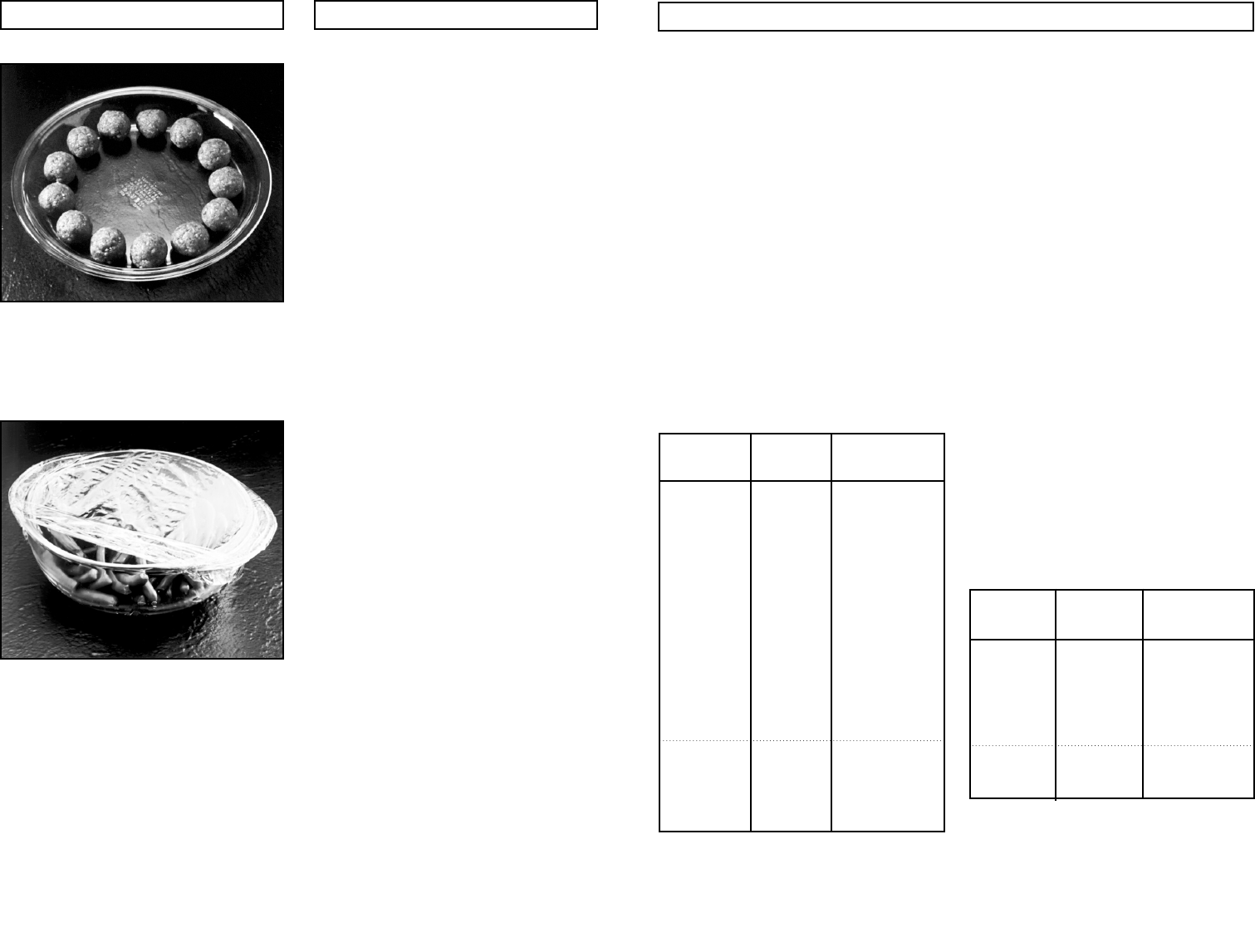
17
16
Meat
1. No special techniques are required. Meat should
be prepared as with conventional cooking.
Season if desired. Always thoroughly defrost
meat before cooking.
2. Place the meat on a microwave roasting rack or
microwave-proof plate and place on the turntable.
3. Cook according to the Meat Cooking Chart
(below). Use the longer time for large meats and
the shorter time for smaller meats. For thicker
chops, use the longer time.
4. Turn the meat once halfway through the cooking
time.
5. Let stand for 5-10 minutes wrapped in foil after
cooking. The standing time is very important as it
completes the cooking process.
6. Make sure meat, especially pork, is thoroughly
cooked before eating.
Poultry
1. No special techniques are required. Poultry
should be prepared as with conventional cooking.
Season if desired.
2. Poultry should be thoroughly defrosted. Remove
giblets and any metal clamps.
3. Prick the skin and brush lightly with vegetable oil
unless the poultry is self-basting.
4. All poultry should be placed on a microwave
roasting rack or a microwave-proof plate and
placed on the turntable.
5. Cook according to the instructions in the Poultry
Cooking Chart below. Turn over halfway through
the cooking time. Because of its shape, poultry
has a tendency to cook unevenly, especially in
very bony parts.Turning during roasting helps to
cook these areas evenly.
6. Let stand for 5-10 minutes wrapped in foil after
cooking before carving. The standing time is very
important, as it completes the cooking process.
7. Make sure poultry is thoroughly cooked before eat-
ing. Whole poultry is completely cooked when the
juices run clear from the inside thigh when it is
pierced with a sharp knife. Poultry pieces should
be pierced with a sharp knife through the thickest
part to ensure that the juices are clear and the
flesh is firm.
WARNING: Do not use aluminum foil during cooking cycle.
BEEF
Standing/Rolled
Rib
– Rare
– Medium
– Well-done
Ground Beef (to
brown for casse-
role)
Hamburgers,
Fresh or defrost-
ed
(4 oz. each)
– 2 patties
– 4 patties
PORK
Loin, Leg
Bacon
– 4 slices
– 6 slices
Microwave
Power
8
8
8
HIGH(100%)
HIGH(100%)
HIGH(100%)
8
HIGH(100%)
HIGH(100%)
Cooking Time
Per Pound
7 to 9 minutes
8 to 10 minutes
9 to 12 minutes
5 to 7 minutes
1 to 3 minutes
2 to 4 minutes
9 to 14 minutes
2 to 4 minutes
3 to 5 minutes
Meat Cooking Chart
CHICKEN
Whole
Breast
(boned)
Portions
TURKEY
Whole
Microwave
Power
8
8
8
8
Cooking Time
Per Pound
6 to 9 minutes
5 to 7 minutes
5 to 7 minutes
6 to 9 minutes
Poultry Cooking Chart
NOTES:
• The times listed above are only a guide.
Allow for difference in individual tastes and
preferences. The times may also vary due to
the shape, cut, and composition of the food.
• If whole poultry is stuffed, the weight of the
stuffed bird should be used when calculating
the cooking time.
NOTE: The times listed above are only a
guide. Allow for difference in individual
tastes and preferences. The times may
also vary due to the shape, cut, and com-
position of the food.
Poultry
COOKING TIPS
Meat
Using Your Microwave Oven
Cooking Techniques Cooking Techniques
Shielding
Thin areas of meat and poultry cook more quickly
than meaty portions. To prevent overcooking,
these thin areas can be shielded with strips of
aluminum foil. Wooden toothpicks may be used to
hold the foil in place.
Timing
A range in cooking time is given in each recipe.
The time range compensates for the uncontrol-
lable differences in food shapes, starting temper-
ature and regional preferences. Always cook food
for the minimum cooking time given in a recipe
and check for doneness. If the food is under-
cooked, continue cooking. It is easier to add time
to an undercooked product. Once the food is
overcooked, nothing can be done.
Stirring
Stirring is usually necessary during microwave
cooking. We have noted when stirring is helpful,
using the words once, twice, frequently or occa-
sionally to describe the amount of stirring neces-
sary. Always bring the cooked outside edges
toward the center and the less cooked center por-
tions toward the outside of the dish.
Rearranging
Rearrange small items such as chicken pieces,
shrimp, hamburger patties or pork chops.
Rearrange pieces from the edge to the center
and pieces from the center to the edge of the
dish.
Turning
It is not possible to stir some foods to redistribute
the heat. At times, microwave energy will concen-
trate in one area of a food. To help insure even
cooking, these foods need to be turned. Turn
over large foods, such as roasts or turkeys,
halfway through cooking.
Stand Time
Most foods will continue to cook by conduction
after the microwave oven is turned off. In meat
cookery, the internal temperature will rise 5°F to
15°F (3°C to 8°C), if allowed to stand, tented with
foil, for 10 to 15 minutes. Casseroles and
vegetables need a shorter amount of standing
time, but this standing time is necessary to allow
foods to complete cooking to the center without
overcooking on the edges.
Testing Doneness
The same tests for doneness used in convention-
al cooking may be used for microwave cooking.
Meat is done when fork-tender or splits at fibers.
Chicken is done when juices are clear yellow and
drumstick moves freely. Fish is done when it
flakes and is opaque. Cake is done when a tooth-
pick or cake tester is inserted and comes out
clean. Candy is done when it reaches the proper
temperature for each stage of crystallization.
Spacing
Individual foods, such as baked potatoes, cup-
cakes and appetizers, will cook more evenly if
placed in the oven equal distances apart. When
possible, arrange foods in a circular pattern.
Covering
As with conventional cooking, moisture evapo-
rates during microwave cooking. Casserole lids or
plastic wrap are used for a tighter seal. When
using plastic wrap, vent the plastic wrap by fold-
ing back part of the plastic wrap from the edge of
the dish to allow steam to escape. Loosen or
remove plastic wrap as recipe directs for stand
time. When removing plastic wrap covers, as well
as any glass lids, be careful to remove them
away from you to avoid steam burns. Various
degrees of moisture retention are also obtained
by using wax paper or paper towels. However,
unless specified, a recipe is cooked covered.
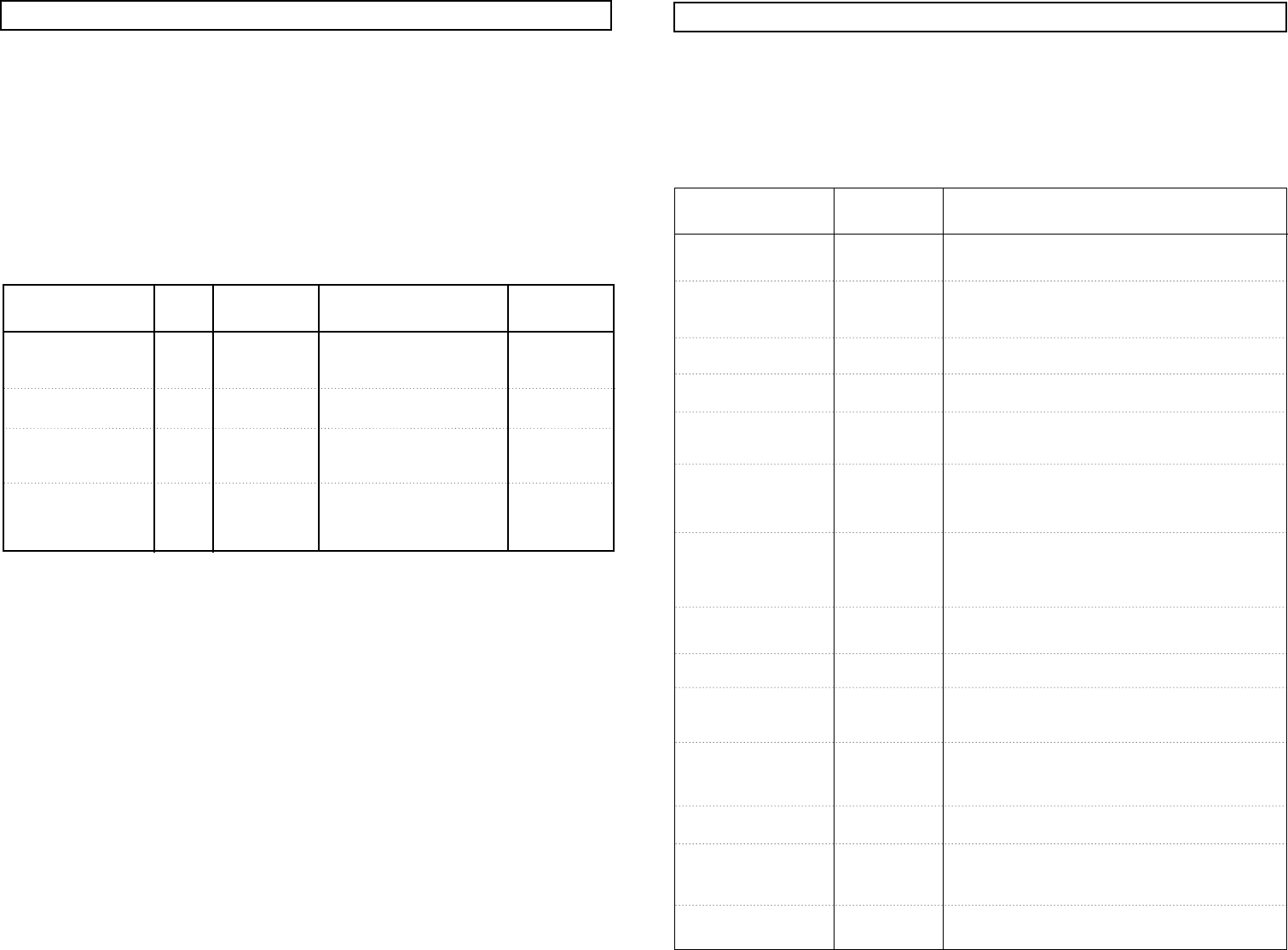
18 19
Heating or Reheating Guide
To heat or reheat successfully in the microwave, it is important to follow several guidelines.
Measure the amount of food in order to determine the time needed to reheat. Arrange the
food in a circular pattern for best results. Room temperature food will heat faster than
refrigerated food. Canned foods should be taken out of the can and placed in a microwav-
able container. The food will be heated more evenly if covered with a microwavable lid or
plastic wrap and vented. Remove cover carefully to prevent steam burns. Use the follow-
ing chart as a guide for reheating cooked food.
Items Cook time Special Instructions
(at HIGH)
Sliced meat Place sliced meat on microwavable plate.
3 slices (1/4-inch thick) 1-2 minutes Cover with plastic wrap and vent.
* Note: Gravy or sauce helps to keep meat juicy.
Chicken pieces
1 breast 2-3 minutes Place chicken pieces on microwavable plate. Cover with
1 leg and thigh 2-3 minutes plastic wrap and vent.
Fish fillet Place fish on microwavable plate. Cover
(6-8 oz.) 1-21/2 minutes with plastic wrap and vent.
Lasagna Place lasagna on microwavable plate. Cover with plastic
1 serving (101/2oz.) 4-6 minutes wrap and vent.
Casserole
1 cup 1-3 minutes COOK covered in microwavable casserole. Stir once
4 cups 4-7 minutes halfway through cooking.
Casserole –
cream or cheese
1 cup 1-3 minutes COOK covered in microwavable casserole. Stir once
4 cups 2-4 minutes halfway through cooking.
Sloppy Joe or
Barbecued beef Reheat filling and bun separately.
1 sandwich 1 -2 minutes Cook filling covered in microwavable casserole. Stir once.
(1/2cup meat filling) Heat bun as directed in chart below.
without bun
Mashed potatoes
1 cup 1-3 minutes COOK covered in microwavable casserole. Stir
4 cups 5-8 minutes once halfway through cooking.
Baked beans COOK covered in microwavable casse role.
1 cup 1-3 minutes Stir once halfway through cooking.
Ravioli or pasta in sauce
1 cup 2-3 minutes COOK covered in microwavable casserole. Stir once
4 cups 6-9 minutes halfway through cooking.
Rice
1 cup 1-3 minutes COOK covered in microwavable casserole. Stir once
4 cups 3-5 minutes halfway through cooking.
Sandwich roll or bun
Wrap in paper towel and place on glass mircrowavable rack
1 roll 15-30 seconds
Vegetables
1 cup 1-2 minutes COOK covered in microwavable casserole. Stir once
4 cups 2-4 minutes halfway through cooking.
Soup COOK covered in microwavable casserole. Stir once
1 serving (8 oz.) 1-2 minutes halfway through cooking.
Using Your Microwave Oven
COOKING TIPS (continued)
Fish
1. Arrange fish in a large shallow non-metallic dish or casserole.
2. Cover with pierced microwave plastic wrap or casserole lid.
3. Place the dish on the turntable.
4. Cook according to the instructions in the Fresh Fish Cooking Chart below. Flakes of
butter can be added to the fish if desired.
5. Let stand as directed in the Cooking Chart before serving.
6. After standing time, check to see that the fish is thoroughly cooked. The fish should be
opaque and flake easily.
Fresh Fish Cooking Chart
Fish
Fish Fillets
Whole Mackerel, Cleaned
and Prepared
Whole Trout,
Cleaned and Prepared
Salmon Steaks
Power
HIGH
HIGH
HIGH
HIGH
Cooking Time
Per Pound
3 to 5 minutes
3 to 5 minutes
4 to 6 minutes
3 to 6 minutes
Standing
Time
2 to 3 minutes
3 to 4 minutes
3 to 4 minutes
3 to 4 minutes
Method
Add 15 to 30 ml
(1 to 2 tbsp.) lemon juice
–
–
Add 15 to 30 ml
(1 to 2 tbsp.) lemon juice
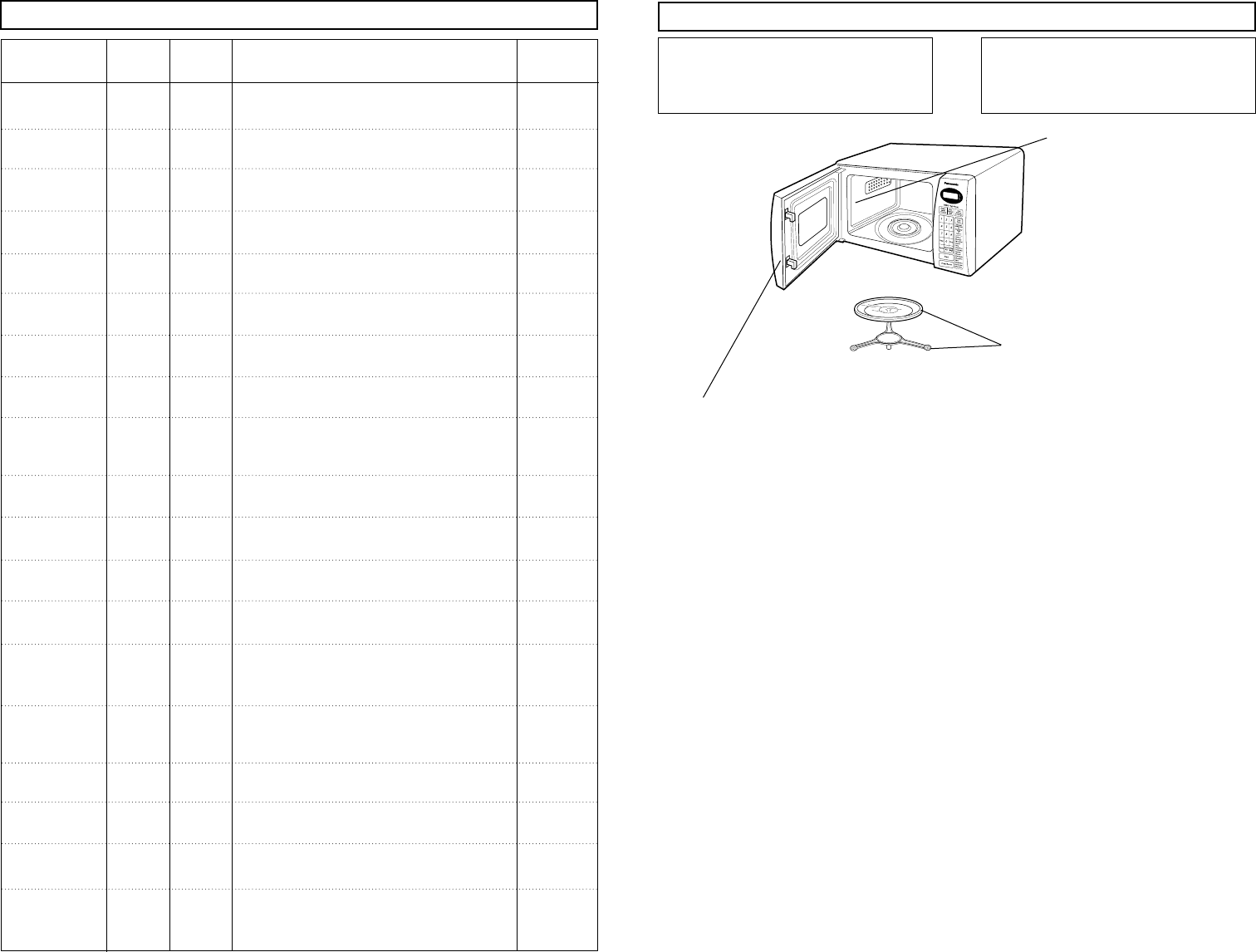
21
Care of Your Microwave Oven
BEFORE CLEANING:
Unplug at socket of the oven. If impossible,
leave oven door open to prevent oven from
accidentally turning on.
AFTER CLEANING:
Be sure to replace the Rotating Ring and
Glass Tray in the proper position and
press Stop/Reset Pad to clear the screen.
INTERIOR
Wipe the oven inside and outside
with a soft cloth and a mild deter-
gent solution. Then rinse and
wipe dry. This should be done
weekly or more often, if needed.
Never use cleaning powders or
rough pads. Excessive oil splat-
ters on the inside top will be diffi-
cult to remove if left for many
days. Wipe splatters with a wet
paper towel, especially after cook-
ing chicken or bacon.
DOOR
For best performance and safety, the
inner door panel and the oven front frame
should be free of food or grease buildup.
Wipe often with a mild detergent; then
rinse and wipe dry. Never use cleaning
powders or rough pads.
REMOVABLE PARTS
The turntable and rotating ring are
removable. They should be hand-washed
in warm (not hot) water with a mild deter-
gent and a soft cloth. Once they are
clean, rinse well and dry with a soft cloth.
Never use cleaning powders, steel wool,
or rough pads.
• The turntable may be cleaned at the
sink. Be careful not to chip or scratch
the edges as this may cause the
turntable to break during use.
• The rotating ring should be cleaned reg-
ularly.
20
Fresh Vegetable Chart
Cook time Standing
at HIGH Time
Artichokes 2 medium 5-7 Trim. Add 2 tsp water and 2 tsp juice. Cover. 2-3 minutes
(8oz. each) 4 medium 7-10
Asparagus, 1Ib. 3-6 Add 1/2cup water. Cover. 2-3 minutes
Fresh, Spears
Beans, Green & 1 lb. 4-7 Add 1/2cup water in 11/2qt. casserole. Stir 2-3 minutes
Wax halfway through cooking.
Beets, Fresh 1 Ib. 5-8 Add 1/2cup water in 11/2qt. covered casserole. 2-3 minutes
Rearrange halfway through cooking.
Broccoli, Fresh, 1Ib. 4-7 Place broccoli in baking dish. Add 1/2cup water. 2-3 minutes
Spears
Cabbage, Fresh, 1Ib. 4-7 Add 1/2cup water in 11/2qt. covered casserole. 2-3 minutes
Chopped Stir halfway through cooking.
Carrots, Fresh, 2 cups 2-4 Add 1/4cup water in 1 qt. covered casserole. 2-3 minutes
Sliced Stir halfway through cooking.
Cauliflower, 1lb. 4-7 Trim. Add 1/4cup water in 1 qt. covered casserole. 2-3 minutes
Fresh, Whole Stir halfway through cooking.
Flowerettes, Fresh
2 cups 2-4
Slice. Add 1/2 cup water in 11/2 qt. covered casserole.
2-3 minutes
Celery, Fresh, 4 cups 5-8 Stir halfway through cooking.
Sliced
Corn, Fresh 2 ears 5-9 Husk. Add 2 tbsp water in 11/2qt. baking dish. 2-3 minutes
Cover.
Mushrooms, 1/2 Ib. 2-3 Place mushrooms in 11/2qt. covered casserole. 2-3 minutes
Fresh, Sliced Stir halfway through cooking.
Parsnips, Fresh, 1Ib. 4-7 Add 1/2cup water in 11/2 qt. covered casserole. 2-3 minutes
Sliced Stir halfway through cooking.
Peas, Green, 4 cups 5-9 Add 1/2cup water in 11/2qt. covered casserole. 2-3 minutes
Fresh Stir halfway through cooking.
Sweet Potatoes 2 medium 5-7 Pierce potatoes several times with fork. 2-3 minutes
Whole Baking 4 medium 8-11 Place on 2 paper towels. 2-3 minutes
(6-8 oz. each) Turn over halfway through cooking.
White Potatoes, 2 potatoes 5-7 Pierce potatoes several times with fork. 2-3 minutes
Whole Baking 4 potatoes 8-11 Place on 2 paper towels. 2-3 minutes
(6-8 oz. each) Turn over halfway through cooking.
Spinach, Fresh, 1Ib. 3-5 Add 1/2cup water in 2 qt. covered casserole. 2-3 minutes
Leaf
Squash, Acorn or 1 medium 4-6 Cut squash in half. Remove seeds. 2-3 minutes
Butternut, Fresh Place in 8 x 8-inch baking dish. Cover.
Zucchini, Fresh, 1Ib. 4-7 Add 1/2cup water in 11/2qt. covered casserole. 2-3 minutes
Sliced Stir halfway through cooking.
Zucchini, Fresh, 1Ib. 4-8 Pierce. Place on 2 paper towels. 2-3 minutes
Whole Turn zucchini over and rearrange halfway through
cooking.
Vegetable Amount Instructions
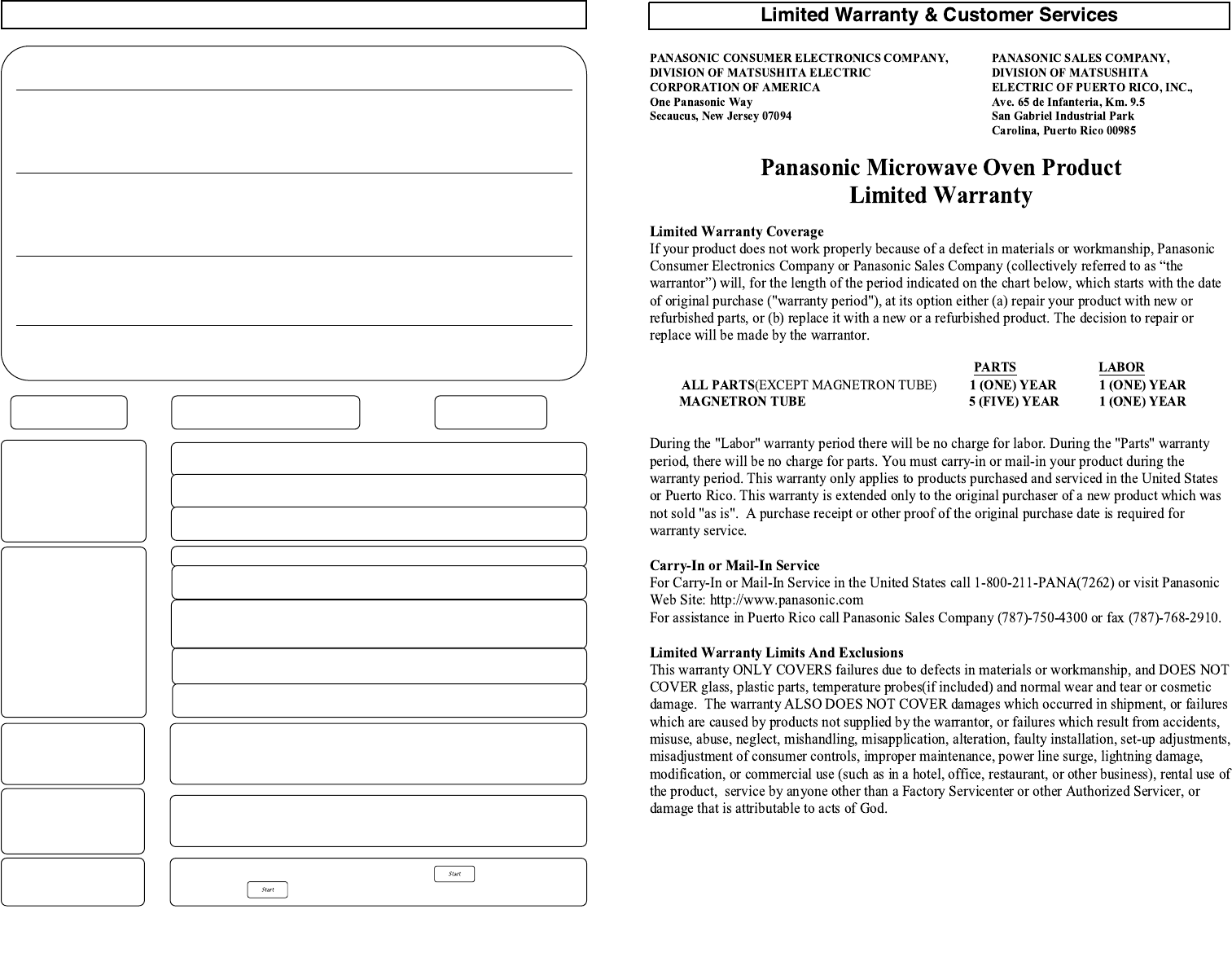
22 23
Before Requesting Service
All these things are normal:
The oven causes Some radio and TV interference might occur when you cook with the
interference with microwave oven. This interference is similar to the interference caused
my TV. by small appliances such as mixers, vacuums, blow dryers, etc. It
does not indicate a problem with your oven.
Steam accumulates During cooking, steam and warm air are given off from the food. Most
on the oven door and of the steam and warm air are removed from the oven by the air which
warm air comes from circulates in the oven cavity. However, some steam will condense on
the oven vents. cooler surfaces such as the oven door. This is normal.
I accidentally ran my Running the oven empty for a short time will not damage the oven.
microwave oven However, we do not recommend operating the microwave oven
without any food in it. without any food in it.
The oven lights dim. When cooking with a power other than HIGH, the oven must cycle to
obtain the lower power levels. The oven light will dim and clicking
noises can be heard when the oven cycle.
PROBLEM POSSIBLE CAUSE REMEDY
Oven will not turn on.
The oven is not plugged in Remove plug from outlet, wait
securely. 10 seconds and reinsert.
Circuit breaker or fuse is Reset circuit breaker or replace
tripped or blown. fuse.
There is a problem with the Plug another appliance into the
outlet. outlet to check if it is working.
Oven will not start
cooking.
The door is not closed completely. Close the oven door securely.
Another program is already Press Stop/Reset Pad to
entered into the oven. cancel the previous program
and enter new program.
➔
➔
Start Pad was not pressed after Press Start Pad.
programming.
Stop/Reset Pad has been pressed Program oven again.
accidentally.
The program is not correct. Program again according to the
Operating Instructions.
The Rotating Ring and oven bottom Clean these parts according to
are dirty. Care of Your Microwave Oven.
When the oven is
operating, there is
noise coming from
the Glass Tray.
➔
The Glass Tray is not positioned Take out Glass Tray and Rotating
properly on the Rotating Ring or there Ring. Wipe with a damp cloth and
is food under the Rotating Ring. reset Rotating Ring and Glass
Tray properly.
The Glass Tray
wobbles. ➔
The CHILD LOCK was activated Hold “ ” pad until “L”
by pressing pad. disappears from the display.
The word “L”
appears in the
Display Window.
➔
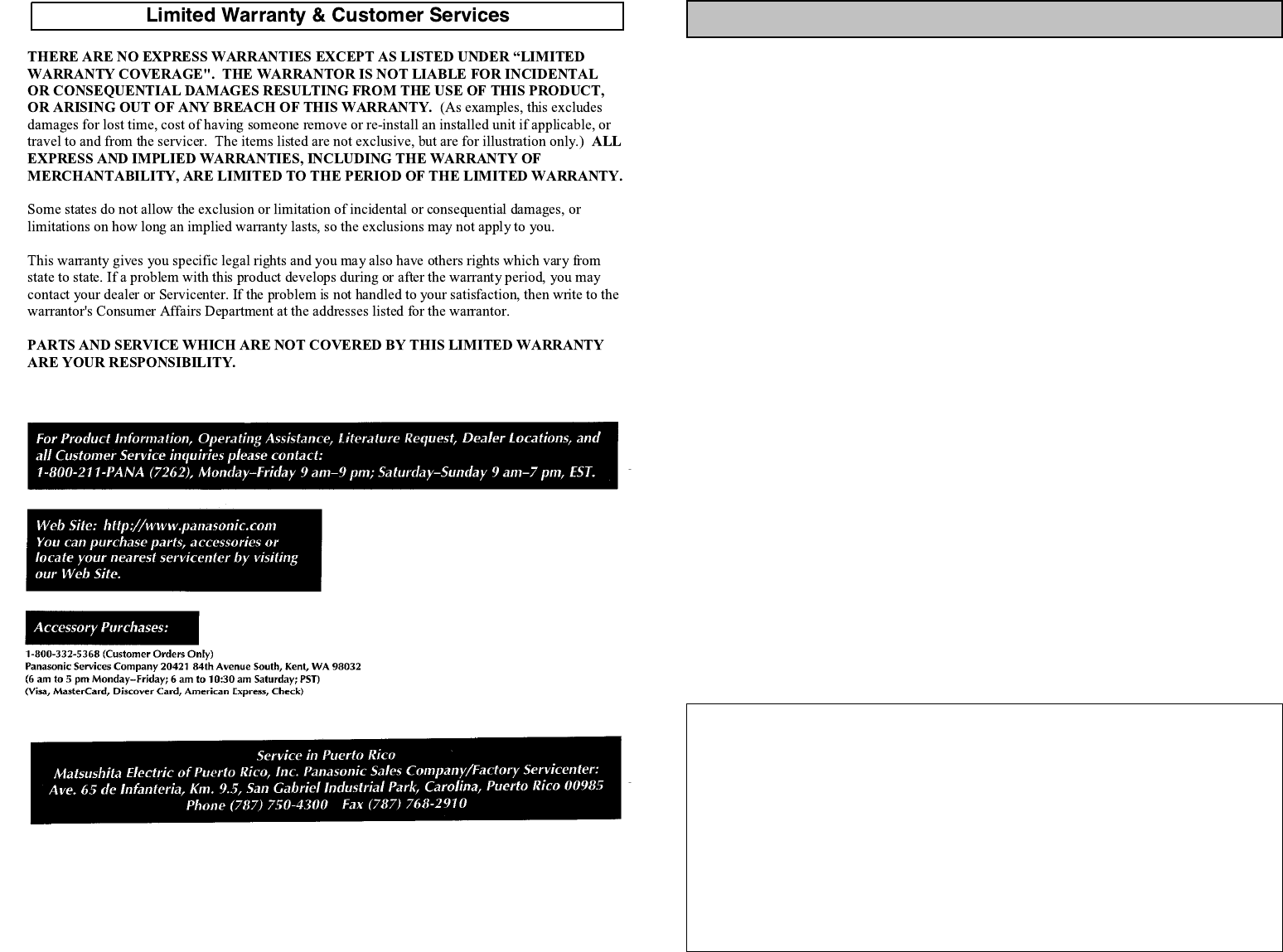
2524
INSTRUCCIONES DE SEGURIDAD
PRECAUCIÓN—To reduce
the risk of burns, electric shock, fire, injury to
persons, or exposure to excessive microwave
energy:
1. Lea todas las instrucciones antes de usar el
aparato.
2. Lea y siga las “PRECAUCIÓNES PARA EVI-
TAR POSIBLE EXPOSICION EXCESIVA A
ENERGIA DE MICROONDAS” especificas,
que se encuentran abajo.
3. Este aparato debe ser conectado a tierra.
Conecte solamente a la toma eléctrica debida-
mente conectada a tierra. Vea las “INSTRUC-
CIONES PARA CONEXIÓN A TIERRA” que
se encuentran en la página 24.
4. Instale o ubique este aparato solamente de
acuerdo con las instrucciones de instalación
que se encuentran en la página 25.
5. No cubra ni tape ninguna de las rendijas de
este aparato.
6. No almacene o use este aparato en exteriores.
No use este aparato cerca del agua - por
ejemplo, cerca del fregadero de la cocina, en
una base mojada, o cerca de una alberca, y
similares.
7. Use este aparato sólo para los fines para los
que fué hecho, tal como se describen en este
manual. No use químicos o vapores corrosivos
en este aparato. Este tipo de horno está
específicamente diseñado para calentar o coci-
nar alimentos. No fué diseñado para uso
industrial o de laboratorio.
8. Cuando limpie las superficies de la puerta y el
horno que vienen juntas al cerrar la puerta,
use solamente jabones no abrasivos o deter-
gentes suaves aplicados con una esponja o
con tela suave.
9. No permita a los niños usar este aparato, a
menos que sean supervisados muy de cerca
por un adulto.
10. No use este aparato si tiene dañado el cordón
o la clavija, si no está trabajando adecuada-
mente, o si ha sido dañado o se ha dejado
caer.
11. No sumergir en agua el cable o la clavija.
12. Mantenga el cordón lejos de superficies
calientes.
13. No deje el cordón colgando en el borde de la
mesa o mostrador.
14. Este aparato debe recibir mantenimiento sólo
de personal calificado. Contacte las instala-
ciones de servicio autorizadas más cercanas
para revisión, reparación o ajuste.
15. Algunos productos, tales como los huevos
completos y contenedores sellados - por ejem-
plo frascos de vidrio cerrados - pueden
explotar y no deben ser calentados en este
horno.
16. Para reducir el riesgo de incendio en la cavi-
dad del horno:
(a) No sobrecocine los alimentos. Preste aten-
ción cuidadosamente al aparato. El papel,
plástico u otros materiales combustibles son
colocados dentro del horno para facilitar la
cocción pero si no se utilizan adecuadamente
esto puede producir incendio en su horno.
(b) Quite los sujetadores de alambre de las bol-
sas de papel o plástico antes de colocar la
bolsa en el horno.
(c) Quite los sujetadores de alambre de las bol-
sas de papel o plástico antes de colocar la
bolsa en el horno.
(d) No use la cavidad con propósitos de almace-
naje. No deje productos de papel, utensillos
de cocina o alimentos en la cavidad cuando
no esté en uso.
Su horno de microondas es un articulo para cocinar y usted debe usarlo con tanto cuidado como usa una
estufa o cualquier otro articulo para cocinar.
Cuando utilice este aparato electrico, se deben sequir precauciones básicas de seguridad, incluyendo las
siguientes:
Guarde estas instrucciones
PRECAUCIÓNES PARA EVITAR
POSIBLE EXPOSICION EXCESIVA
A ENERGIA DE MICROONDAS
(a) No intente hacer funcionar este horno con la
puerta ablerta ya que esto puede resultar peli-
groso. Es importante no anular o biogear los
mecanismos de seguridad.
(b) No coloque ningún objeto entre el panel frontal
del horno y la puerta, ni permita que se acu-
mule basura o residuos de limpiadores en las
superficies de sellado.
(c) No haga funcionar el horno si está dañado, es
importante que la puerta del horno abra y cierre
apropiadamente:
(1) la puerta (combada)
(2) bisagras y seguro de la puerta (rotos o
sueltos)
(3) sellos de las puertas y superficies de sellado
(d) El horno o deberá ser ajustado o reparado por
ninguna persona, excepto el personal de servi-
cio debidamente calificado.
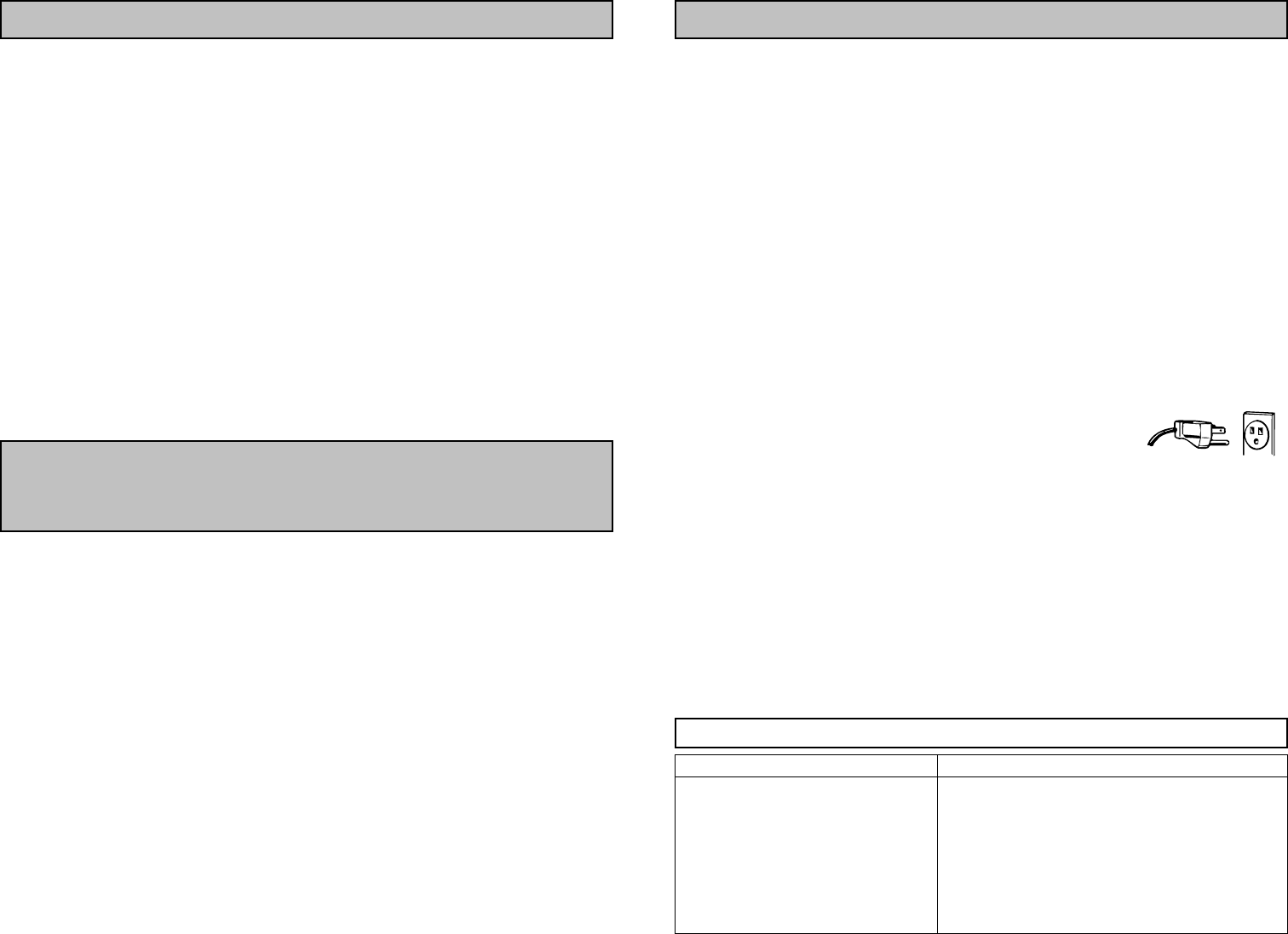
26 27
Examine Su Horno
Desempaque el horno, quite todo el material de
empaque y examine que su horno no tenga ningún
daño, tales como abolladuras, seguros de la puer-
ta rotos o resquebrajaduras en la puerta. Notifique
inmediatamente a su distribuidor si el horno está
dañado.
Ubicación del Horno
1. El horno debe ser colocado en una superficie
plana y estable. Para su operación apropiada, el
horno debe tener suficiente corriente de aire.
Deje 10 cm de espacio de ambos lados del
horno y 10 cm de espacio en la parte superior
del horno.
a.NO
bloquear la ventilación del aire.
Si es bloqueada la ventilación del aire
durante la operación, el horno puede sobre-
calentarse y quemarse.
Cuando use algún trapo, franela o funda
para cubrir el horno, las tomas y salidas del
aire no deberán ser bloqueadas. Tambien
debe tener un espacio apropiado para la
parte trasera y los costados.
b.NO coloque el horno cerca de una superficie
húmeda caliente, tal como un registro de gas
o eléctrico.
c.NO opere el horno cuando la humedad del
cuarto sea muy alta.
2. Este horno ha sido fabricado para uso en el
hogar solamente.
Interferencia de Radio
1. La operación de su horno de microondas puede
causar interferencia en su radio, TV o equipo
similar.
2. Cuando hay interferencia, se puede reducir o
eliminar tomando las siguientes medidas:
a.Limpie la puerta y las superficies selladoras
del horno.
b.Ponga el radio, TV, etc. lo más lejos posible
del horno de microondas.
c.Use una antena instalada adecuadamente
para obtener una recepción de señal más
fuerte.
Requerimientos
de cableado
1. El horno debe estar en un circuito separado.
Ningún otro aparato debe compartir el circuito
con el horno. Si lo hace el fusible del circuito
puede estallar, el bloqueador del circuito tra-
barse o la comida cocinarse más lento que en
los tiempos recomendados en este manual.
2. El voltaje usado debe ser el mismo al especifi-
cado en el horno de microondas (120 V.). Usar
un voltaje más alto es peligroso y puede resul-
tar en fuego u otro accidente causando daño al
horno. Usar un bajo voltaje dará como resultado
un cocinado más lento. Panasonic no se hace
responsable por daños resultantes del uso del
horno con otros voltajes que no sea el especifi-
cado.
3. El horno debe ser conectado en un enchufe a
tierra de al menos 20 amp 120 volt, 60 Hz.
Donde se encuentre un enchufe estándar de 2
entradas es responsabilidad y obligación del
consumidor reem-
plazarlo por un
enchufe a tierra de 3
entradas.
INSTRUCCIONES DE INSTALACIÓN
*Determonado de acuerdo a procedimientos contemplados en la nomal IEC 60705.
Las expecificaciónes estàn sujetas a cambios sin previo aviso.
Especificaciones Técnicas
Potencia Fuente de Poder:
Potencia de Salida:*
Dimensiónes Exteriores
(Alto x Ancho x Fondo):
Dimensiónes Cavidad del Horno
(Alto x Ancho x Fondo):
Frecuencia:
Peso Sin Embalaje:
13,5 Amps, 1600 W
1200 W
344 x 573,5 x 440 mm
261 x 420,7 x 417,1 mm
2450 MHz
Aprox. 16,9 kg
MS-164ZF
Uso General
1. NO altere o haga ningún ajuste o reparación a
la puerta, al alojamiento del panel de control,
interruptores entrecruzados de seguridad o a
cualquier otra parte del horno. NO quite el panel
exterior del horno. Las reparaciones deben ser
hechas solamente por personal de servicio cali-
ficado.
2. NO opere el horno vacío. La energía de
microondas se reflejará continuamente a través
del horno si los alimentos o agua no están pre-
sentes para absorber energía. Esto puede
dañar el horno y resultar en peligro de incendio.
3. NO utilice este horno para calentar químicos o
cualquier otros productos no alimenticios. NO
limpie este horno con cualquier producto etique-
tado con contenido químico corrosivo. El calen-
tamiento de químicos corrosivos en este horno
puede causar fugas de radiación.
4. NO seque telas, periódicos u otros materiales
en el horno. Pueden incendiarse.
5. NO use productos de papel reciclado, ya que
pueden contener impurezas que pueden causar
chispas y/o incendios cuando se usen.
6. NO use periódicos o bolsas de papel para coci-
nar. Puede causar un incendio.
7. NO pegue, NO golpee el panel de control.
Pueden causarse daños a los controles. Puede
causar un incendio.
8. Las manoplas para tomar cosas calientes siem-
pre deben ser utilizados cuando se retiren
cosas de el horno. El calor se transfiere de los
alimentos calientes a los contenedores para
cocinar y de los contenedores a la Bandeja de
Cristal. La Bandeja de Cristal puede estar muy
caliente después de sacar los contenedores
para cocinar del horno.
9. NO almacene materiales flamables cerca, arri-
ba, o dentro del horno. Pueden ser riesgos de
incendio.
Este aparato debe ser conectado a tierra. En el
caso de un corto circuito, la conexión a tierra
reduce el riesgo de una descarga eléctrica propor-
cionando una línea de escape para la corriente
eléctrica. Este aparato está equipado con un cable
y clavija para conexión a tierra. La clavija debe ser
conectada en un receptor que esté instalado ade-
cuadamente y conectado a tierra.
PRECAUCION - El uso inapropiado de la clavija
para conexión a tierra puede resultar en riesgo de
descarga eléctrica.
Consulte a un electricista o a personal de servicio
calificados, si las instrucciones para conectar a
tierra no son completamente comprendidas o si
existe duda de que el aparato está correctamente
conectado a tierra. Si es necessario usar un cable
de extensión, use solamente cable de extensión
de tres hilos que tenga una clavija de tres
entradas para conectar a tierra, y un receptor de
tres ranuras que acepte la clavija del aparato. El
calibre marcado en el cable de extensión debe ser
igual o mayor al calibre eléctrico del aparato.
Suministro Eléctrico
1. Se provee un cable de suministro eléctrico corto
para reducir los riesgos resultantes de
enredarse o tropezarse con un cable más largo.
2. Juegos de cable más largos o extensiones
están disponibles y pueden utilizarse si se usan
con cuidado.
3. Si se usa un cable más largo o extensión, (1) el
calibre eléctrico marcado en el juego de cordón
o extensión debe ser al menos tan grande como
el calibre eléctrico del aparato, (2) el cable de
extensión debe ser de tres hilos del tipo de
conexión a tierra, y (3) el cordón más largo
debe ser arreglado de tal forma que no caiga
sobre la cubierta del mostrador o de la mesa
donde pueda ser jalado por niños o tropezarse
accidentalmente.
INSTRUCCIONES DE SEGURIDAD
INSTRUCCIONES PARA
CONEXIÓN A TIERRA
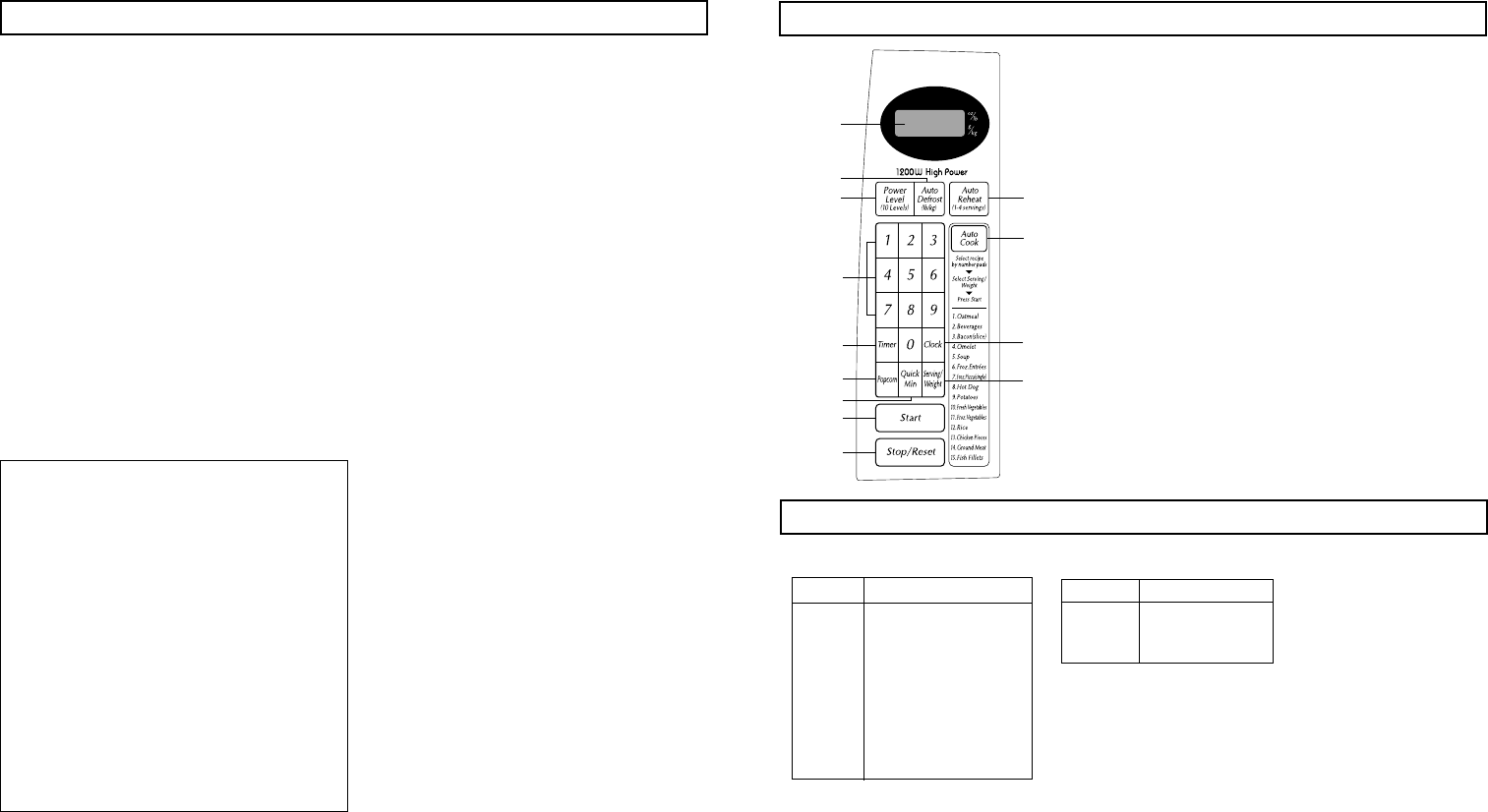
28 29
Panel de Control
(1) Pantalla indicadora
(Ventana de Visualización)
(2) Cocción a tiempo programado
(3) Pulsador de potencia
(4) Pulsador de recalentamiento automático
(5) Pulsadores de auto cocción
(6) Pulsadores de numéricos
(7) Pulsador de tiempo
(8) Pulsador de palomitas de maíz
(9) Pulsador de rapido en minutos
(10) Pulsador de reloj
(11) Pulsador de porción/peso
(12) Pulsador Para Comenzar
(13) Pulsador Para/Cancelar
ባ
ቤ
ቧ
ቨ
ቩቭ
ብ
ቦ
ቢ
ቪ
ቯ
ቫ
ቮ
Sugerencias
Pulse Nivel de Potencia
1 vez P10 (Alto)
2 veces P9
3 veces P8
4 veces P7(Medio-alto)
5 veces P6(Medio)
6 veces P5
7 veces P4
8 veces P3 (Medio-bajo)
9 veces P2
10 veces P1 (Bajo)
Nivel de Potencia
Pulse Peso
1 vez 1.75 oz. (50g)
2 veces 3.0 oz. (85g)
3 veces 3.5 oz. (99g)
Pulsador de Palomitas
Notas:
1. Use los paquetes previamente empacados de palomitas de
maíz para microondas a temperatura ambiente. Lea las
instrucciones del fabricante.
2. Coloque la bolsa en el horno de acuerdo a las instrucciones
del fabricante.
3. Coloque solamente una bolsa a la vez.
4. Después de preparadas, abra la bolsa cuidadosamente, las
palomitas de maíz y el vapor estarán extremadamente
calientes.
5. No vuelva a calentar los granos que no reventaron ni vuelva a
usar la bolsa.
6. Nunca deje el horno desatendido cuando prepare palomitas
de maíz.
Pare el horno cuando la explosión de las palomi-
tas demore entre 2 y 3 segundos. El exceso de cocción
puede hacer que las palomitas se quemen.
7. Devido a la gran variedad de palomitas de maíz para microon-
das en el mercado, tal vez sea necessario poner la bolsa en
la orilla del plato giratorio para obtener mejores resultados.
NOTA ACERCA DE PALOMITAS: Cuando se preparen varias bol-
sas una tras otra, el tiempo de preparación puede variar ligera-
mente. Esto no afecta al resultado de las palomitas.
PRECAUCIÓN: Si el paqute de palomitas de maíz previamente
empacado es de un peso diferente a el recomendado, no use el
sistema indicado para palomitas de maíz, o puede ocurrir que no
se preparen adecuadamente o un incendio. Siga las instruc-
ciones del fabricante.
Sugerencias Utiles
IMPORTANTE
La cocción adecuada depende del tiempo des-
ignado y del peso de los alimentos. Si usa una
porción menor de la recomendada y cocina por
el tiempo para la porción recomendada, puede
resulatar un incendio. Si ocurre un incendio,
ponga el horno en posición de apagado y man-
tengalo cerrado. Desconecte la energia eléctrica
o desconecte la caja de fusibles o el panel de
control.
1) ENLATADO CASERO/ALIMENTOS
DESHIDRATADOS/PEQUEÑAS CANTIDADES
DE ALIMENTOS
• No use su horno para el enlatado casero o para
calentar cualquier frasco cerrado. La presión
aumentará y el frasco puede explotar. Su horno
no puede mantener los alimentos a la temperatu-
ra apropiada de enlatado.
• Pequeñas cantidades de alimento o alimentos
con bajo contenido de humedad se pueden secar,
quemar o incendiarse.
• No seque alimentos, hierbas, frutas o vegetales
en su horno.
3) FREIR CON MUCHA GRASA
• No trate de freir con mucha grasa en su horno de
microondas. Cocinar aceites puede estallar en
flamas y puede causar daño al horno y quiza
acabar en quemaduras. Los utensillos de
microondas pueden no ser utiles para soportar la
temperatura del aceite caliente, y podrían
romperse.
4) HUEVOS
• No caliente huevos en su cascaron en el horno
de microondas. La presión subirá y el huevo
explotará.
5) ALIMENTOS CON PIELES NO POROSAS
• Papas, manzanas, yemas de huevo, calabazas
completas y salchichas son ejemplos de alimen-
tos con pieles no porosas. Estos tipos de alimen-
tos deben ser perforados antes de cocinarlos en
Microondas para evitar que Estallen.
• Use papas frescas para hornear y cocinelas
hasta que esten listas. Cocinar demasiado causa
deshidratación y puede producir un incendio. Use
los pesos recomendados o puede ocurrir un
incendio.
6) LIQUIDOS
• Los liquidos pueden "sobrecalentarse" en el
microondas y, cuando el recipiente se desplaza
en un sentido, los liquidos sobrecalentados
pueden "desbordarse" fuera del recipiente.
El agua "sobrecalentada" es más caliente que el
agua hervida, AUNQUE NO HAGA BURBUJAS.
Para reducir la posibilidad de que esto ocurra,
siempre debe agitar con fuerza los liquidos
antes de calentarlos para que el liquido se mez-
cle con aire. NO CALIENTE NUNCA LOS LIQUI-
DOS DURANTE UN TIEMPO PROLONGADO.
7) BANDEJA DE CRISTAL/UTENSILIOS DE
COCINA/PAPEL ALUMINO
• Los utensillos para cocinar se calientan durante la
cocción en microondas. Use soportes para lo
caliente, cuando saque los utensillos del horno o
cuando quite tapas o cubiertas de envoltura de
plástico de los utensillos de cocina, para evitar
quemaduras.
• La bandeja de cristal se calentará durante la
cocción. Debe permitirse que se enfrie antes de
manejarla o antes de colocar productos de papel,
tales como platos de papel o bolsas de palomitas
de maíz para microondas, para cocinar.
• Cuando se use papel aluminio, brochetas, rejillas
para calentar o utensilios hechos de metal en el
horno, deje por lo menos 2,5 cm de espacio entre
el material de metal y las paredes interiores del
horno. Si arquea (chispea) quite el material de
metal (brochetas etc.) y/o cambielo a un contene-
dor no metálico.
• Platos con adornos metálicos no deberan ser
usados, ya que puede producirse arco eléctrico.
8) TOALLAS DE PAPEL/TELAS
• No use toallas de papel o telas que contengan
fibras sinteticas en su tejido. La fibra sintetica
puede causar que la toalla se incendie.
• No use bolsas de papel o productos de papel
recilado en el horno de microondas.
9) BANDEJA DORADOR/BOLSAS PARA COCI-
NAR EN HORNO
• Los bandeja doradora o asados son diseñados
para cocinar en microondas solamente. Siempre
siga las instrucciones dadas por el fabricante. No
precaliente la bandeja doradora mas de 8 min.
• Si se usa una bolsa para cocinar para el microon-
das, prepare de acuerdo a las instrucciones del
paquete. No use sujetadores de alambre para
cerrar la bolsa.
10) TERMÓMETROS
• No use termómetros convencionales para alimen-
tos en su horno. Puede producir arco.
11) GUÍA DE USO GENERAL DEL
HORNO/PUERTA DEL HORNO
• No use el horno por cualquier razón que no sea la
preparación de alimentos.
• No deje sin atención el horno mientras esté en uso.
Siga Esta Precauciones de Seguridad Cuando Cocine en Su Horno
2) PALOMITAS DE MAÍZ
Las palomitas de maiz deben prepararse en un
recipiente para palomitas de maiz adecuado para
horno de microondas. Palomilas de maiz para
horno de microondas que se preparan en su pro-
pio paquete también están disponibles. Siga las
instrucciones del fabricante de palomitas de maiz
y use una marca adecuada para la potencia de
su horno de microondas. Nunca deje desalendi-
do el horno cuando prepare palomitas de maiz.
PRECAUCIÓN
Cuando use palomitas de maiz para microon-
das previamente empacado siga las instruc-
ciones recomendadas en el paquete. Revise
el peso del paquete antes de usar la tecla de
palomitas de maíz. Prepare el horno para el
peso del paquete de palomitas de maíz . Si no
se siguen estas instrucciones, las palomitas
de maíz pueden no reventar adecuadamente
o pueden encenderse y causar un incendio.
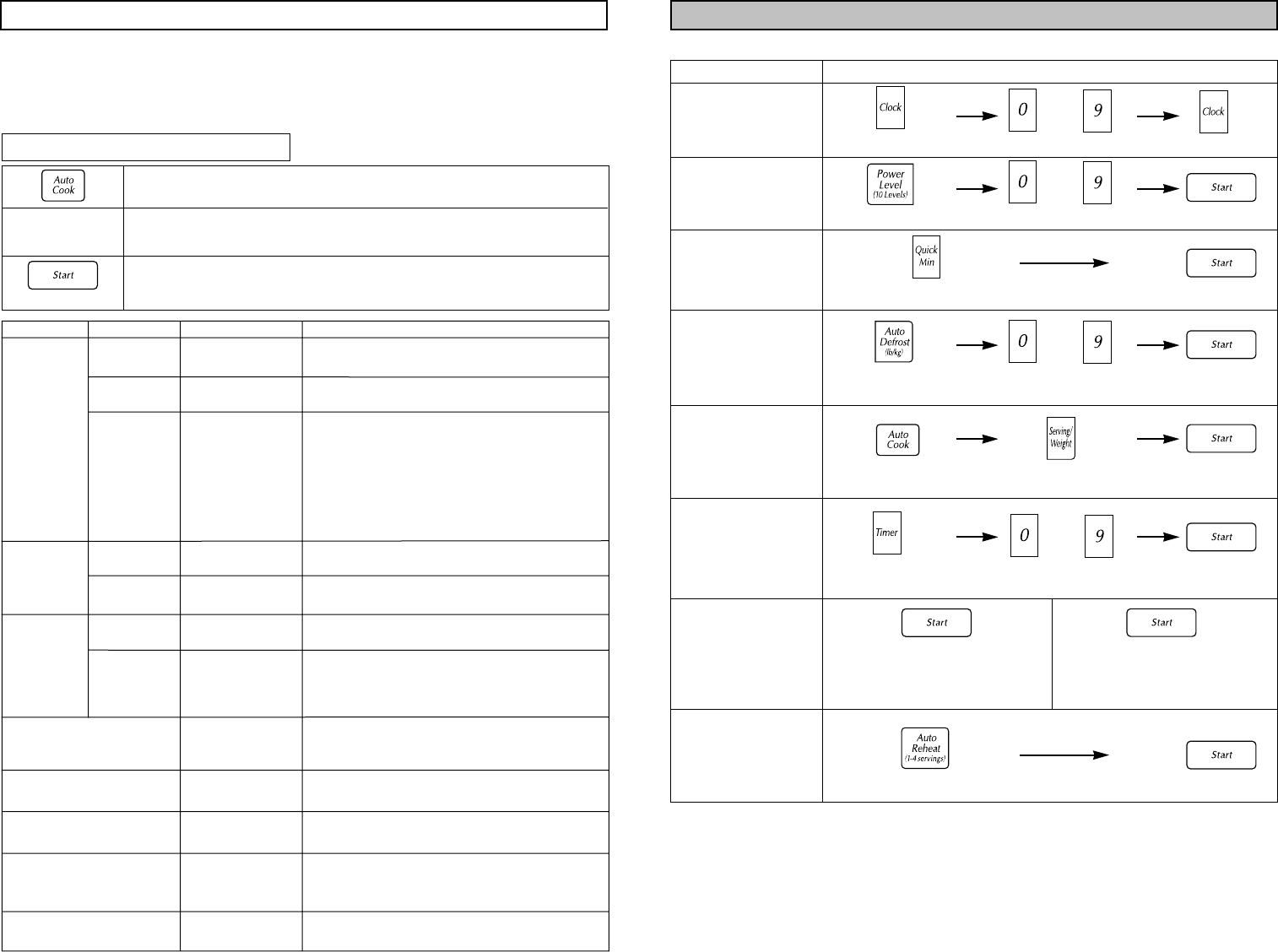
30 31
Para Poner el Reloj en
la Hora
Para Ajuste de
Potencia y Tiempo
Minuto Automático
Para Descongelar
usando el pulsador
Para Usar como en
temporizador de
cocina
Traba Para
Niños-Activacion
Para recalentar
usa Auto Reheat
palsador
Registre la hora o dia.
Fije el peso.
Presione. Presione.
Presione.
Seleccione potencia.
(hasta a 10)
Presione.
Mantenga “Start” presionado hasta
que el siguiente mensaje aparezca
en el indicador “L” y se escuchen
dos “beeps”
Presione y mantenga presionda la
tecla “Start” hasta que la leyenda
“L” desaparezca delindicador.
Presione.
Presione.
Presione.
Para Cocinar usando
el Pulsador Auto
Cocción
Establezca el tiempo de cocción.
GUIA RAPIDA DE OPERACIÓN
Caracteristica Como Operala
a
a
a
a
eg.
Seleccione Recipe Seleccione porciones/peso
Presione.
Presione. Presione.
Presione.
Gráfico de cocción automática
1. • Seleccione la categoria deseada.
2. • Seleccione porciones/peso.
➤Verifique el peso en la Ventana de Visualizacion.
3. •
Presione Encender.
➤Aparece el tiempo de coccion. La Ventana de Visualizacion
realiza una cuenta regresiva..
Esta función le permite cocinar la mayor parte de sus alimentos favoritos y algunas recetas nuevas gracias
al Nuevo Sistema de Cocción con Inverter.
Podrá cocinar sin necesidad de ajustar ni la oitencia ni el tiempo. Estos alimentos ya han sido probados y
pretemporizados locales de la alimentación eléctrica ni los gustos individuales. En caso de que prefiera
cocinar los alimentos de una manera diferente, utilice el método de Potencia y Tiempo que aparece en la
página 7.
Ejemplo: Para cocinar 300g Entradas congelados
DESAYUNO ALIMENTOS CANTIDAD/PESO SUGERENCIAS
Desayuno 1.Avenas 0,5, 1 tazas Siga las instrucciones del fabicante para
cantidades de liquido, cubierta o mesclado.
2.Bebidas 1, 2 tazas Siga las instrucciones del fabicante para
cantidades de liquido, cubierta o mesclado.
3.Tocino 4 rebanadas Use un plato rigido. Cubralo con toallas de
(100-133 g) papel. Si el bacon no se cocina a su gusto,
6 rebanadas continúe calentándolo añadiendo más tiempo.
(150-183 g)
10 rebanadas
(260-300 g)
14 rebanadas
(366-400 g)
Comida 4.Sopa 1, 2 tazas Siga las instrucciones del fabricante para
cantidades de liquido, cubierta o mesclado.
5.Pizza 110, 225 g Siga las instrucciones del fabricante.
Congelada
Cena 6.Piesas 170,340,500,680 g. Ponglas con la piel hacia arriva, cubralas
de Pollo con plastico de cocina.
7.Carne 450, 900 g Separela en pequeñas porciones un plato
Molida de Cristal. Cubrala con plastico de cocina.
Despues de 2 “beeps” voltee la carne. El
jugo deve ser transparente.
8. Alimentos
225, 300, 600, 900 g
Siga las instrucciones del fabricante. No agrege
Congelados sal hast dispues de la coccion. Si necesita más
tiempo, continúe cocinando de forma manual.
9.Papas 1, 2, 3, 4 piesas Pique la cascara a con un tenedor.
(170-225 g)
10.Vegetales
110, 225, 340, 450 g
Todas las piesas deben ser del mismo tamaño.
Fresco Agrebe agua, cubralo con una tapa o plastico.
11.Vegetales 170, 300, 450 g Siga las instrucciones del fabricante. No
Congelados agrege sal hasta despues de la coccion.
Use menos agua que la recomendada.
12.Arroz 0,5, 1, 1,5 tazas Use aqua caliente en un recipiente para
microondas. Cubralo (deve tener ventilacion).